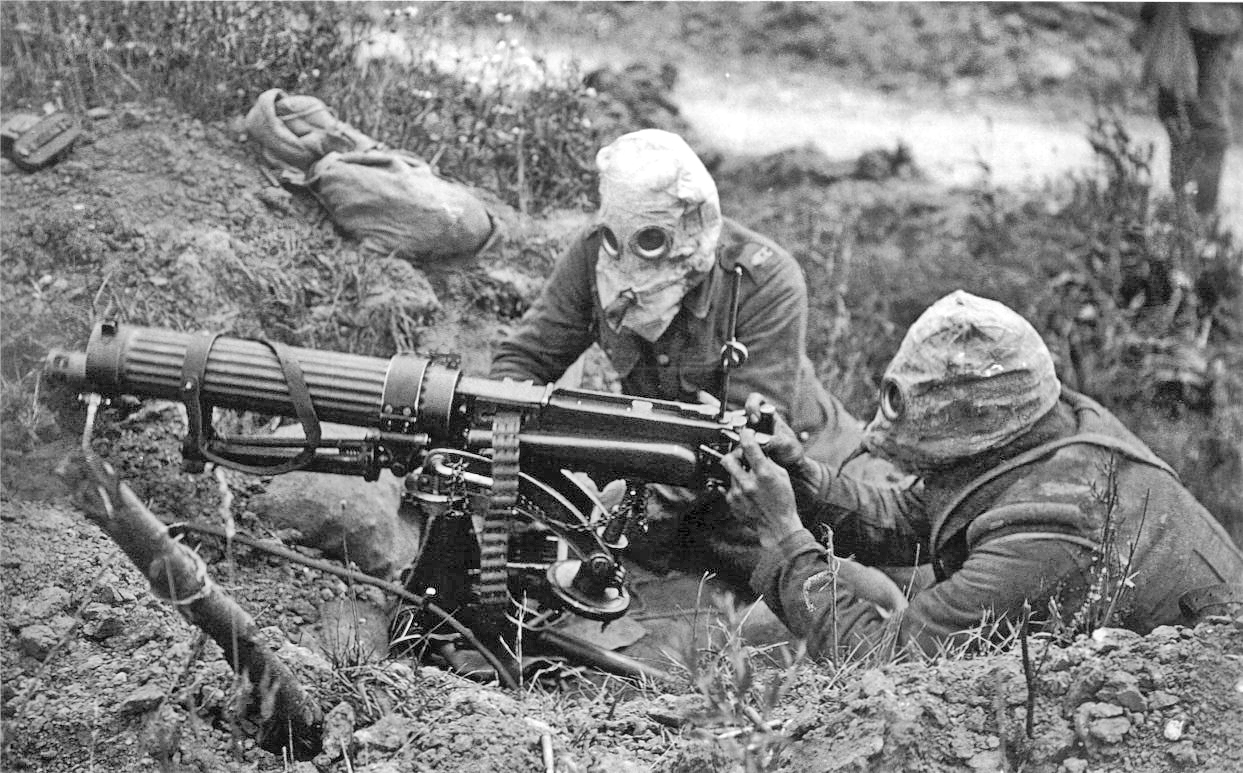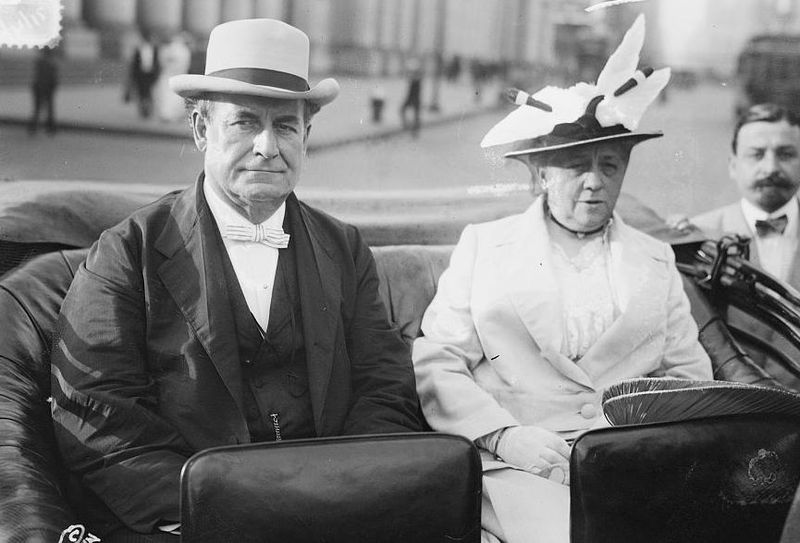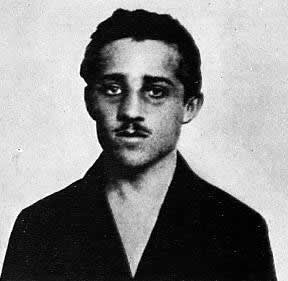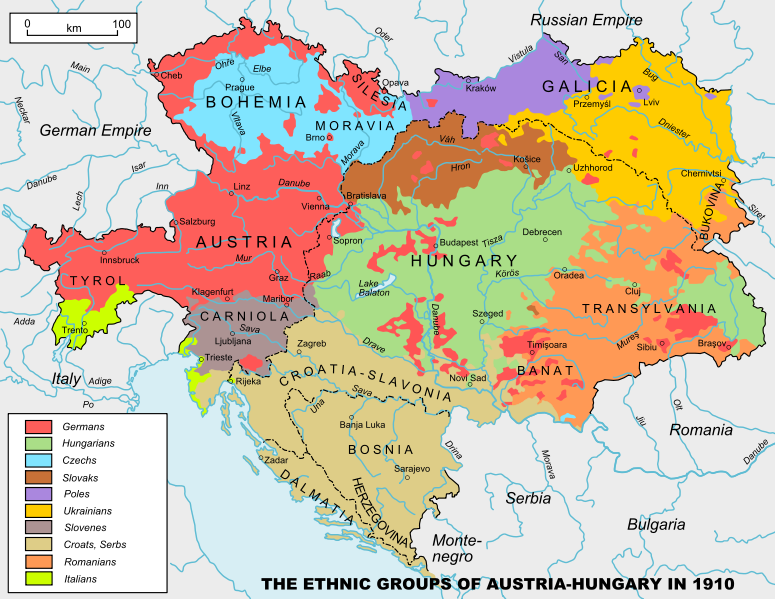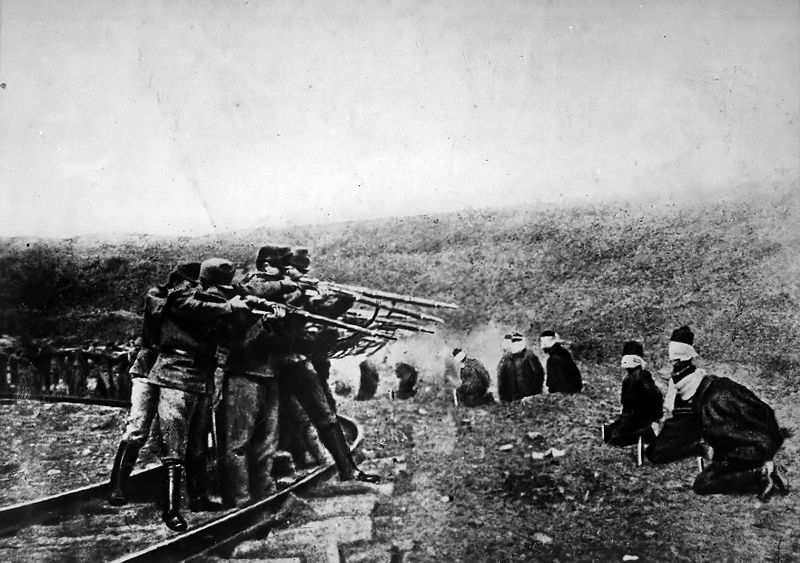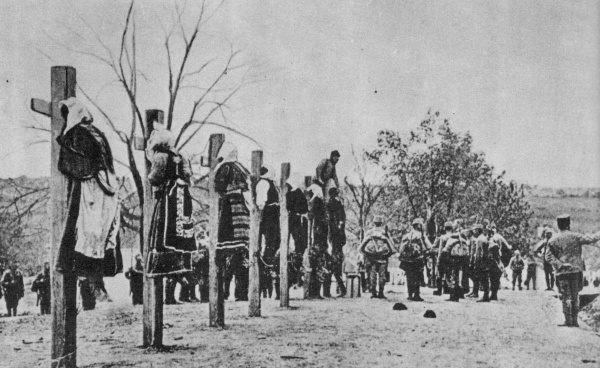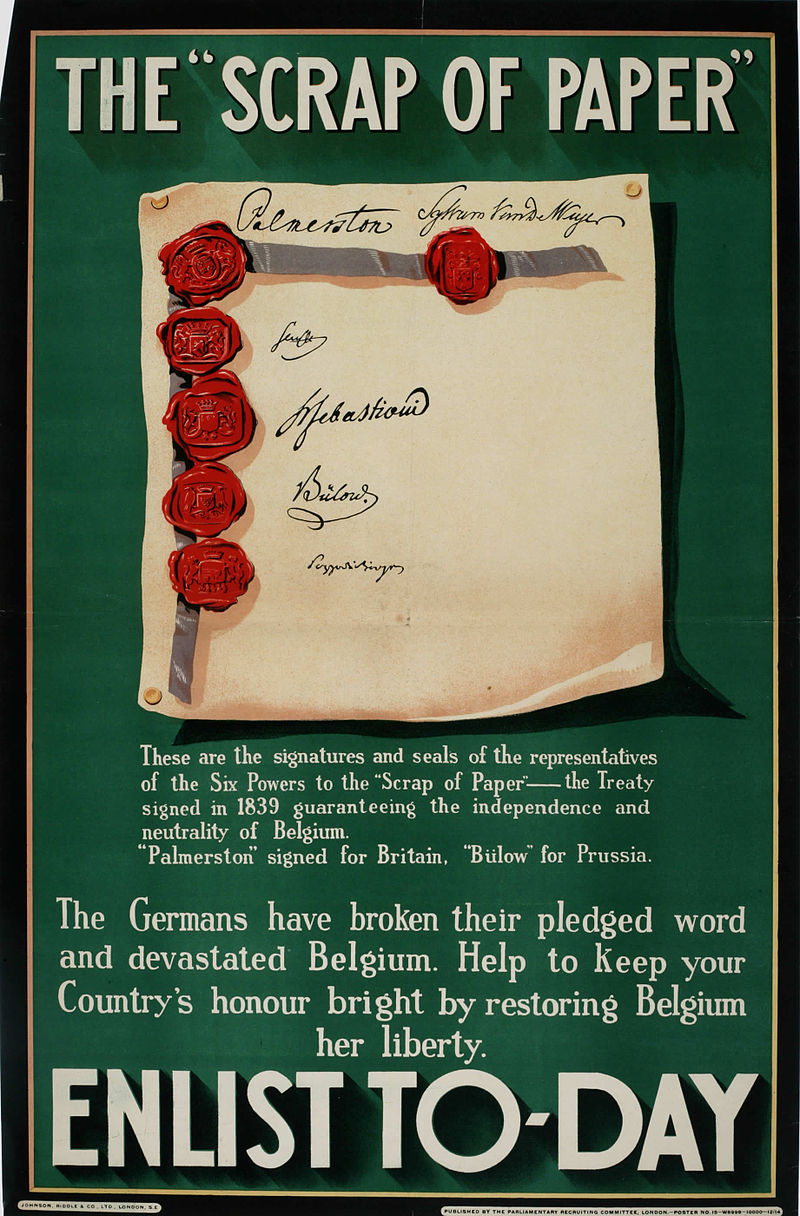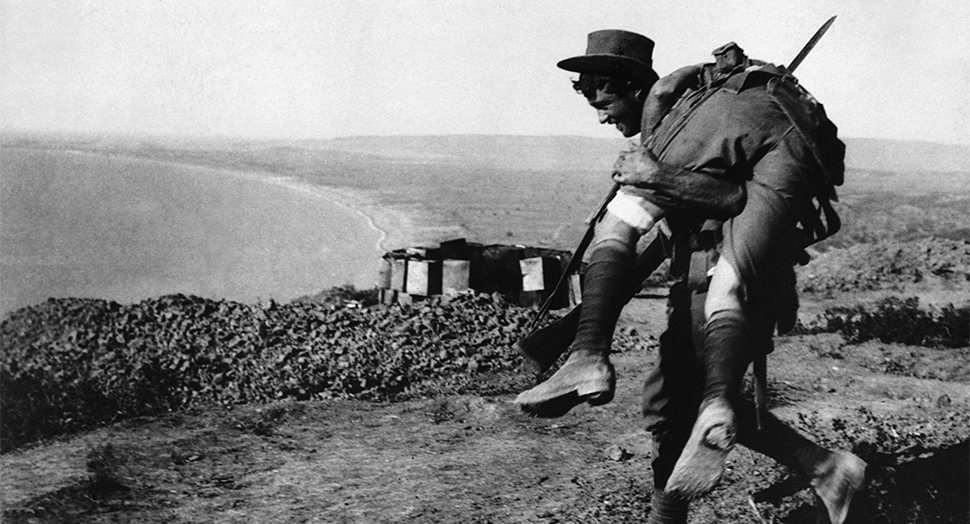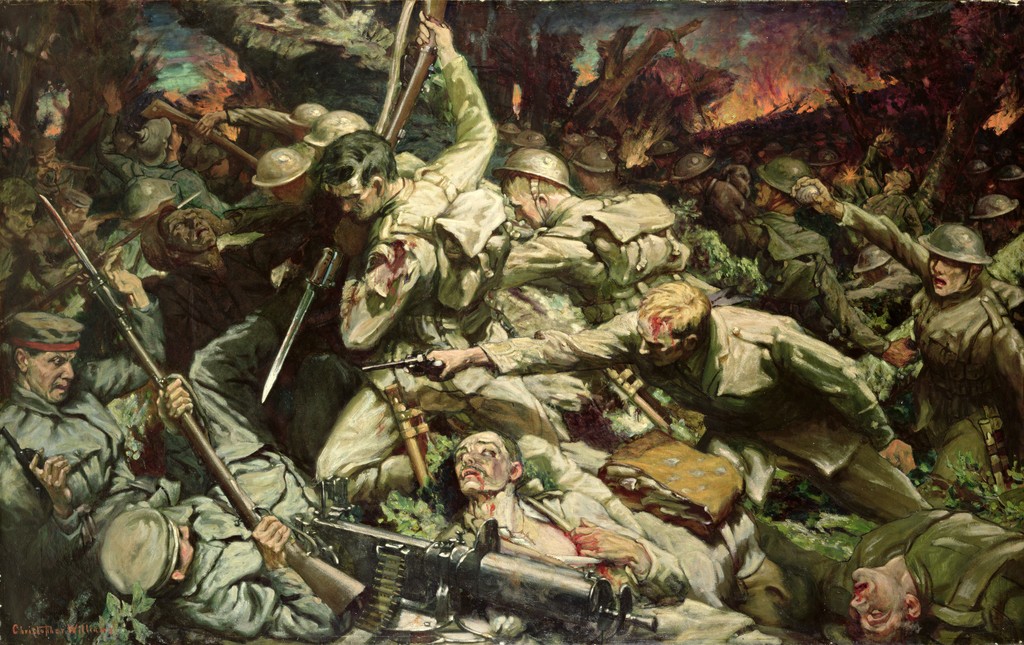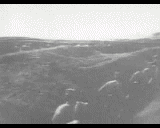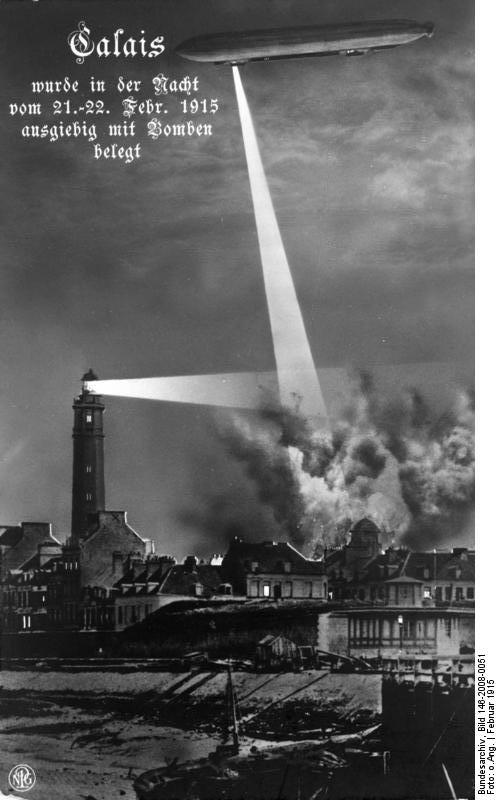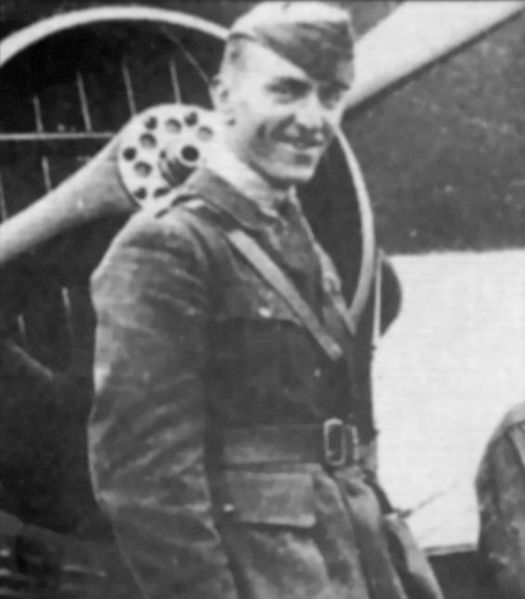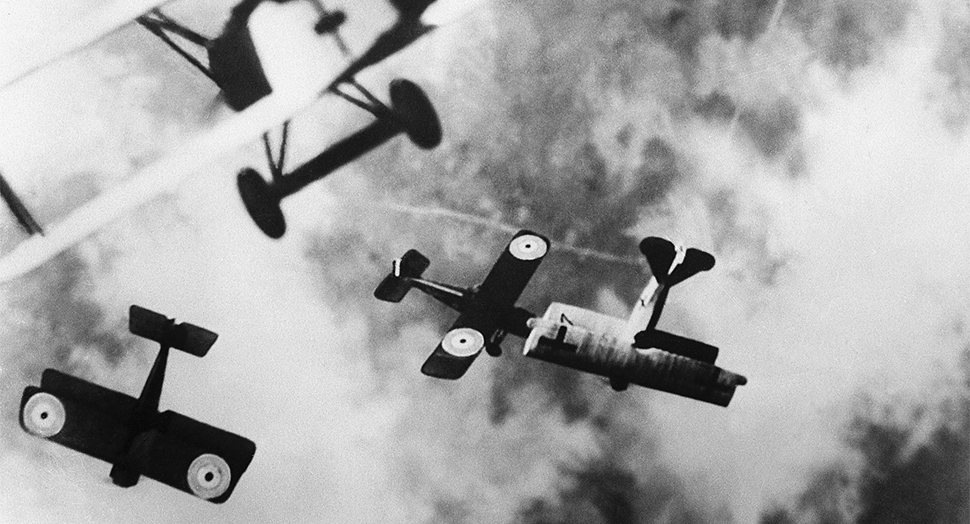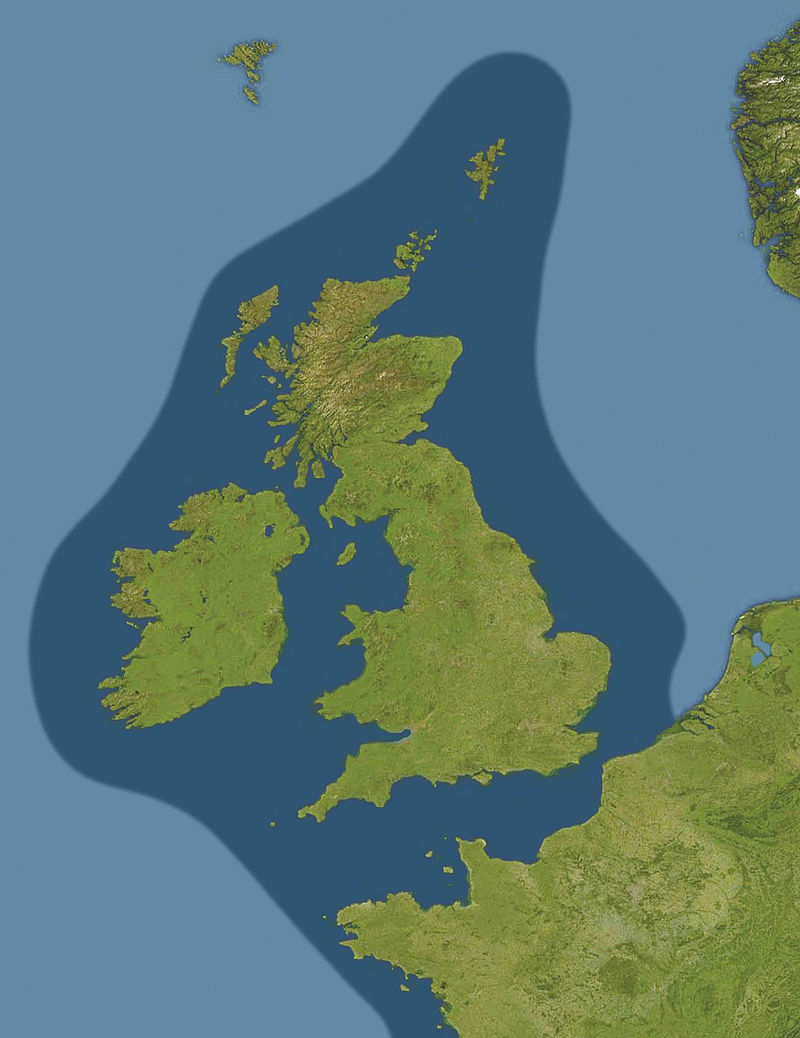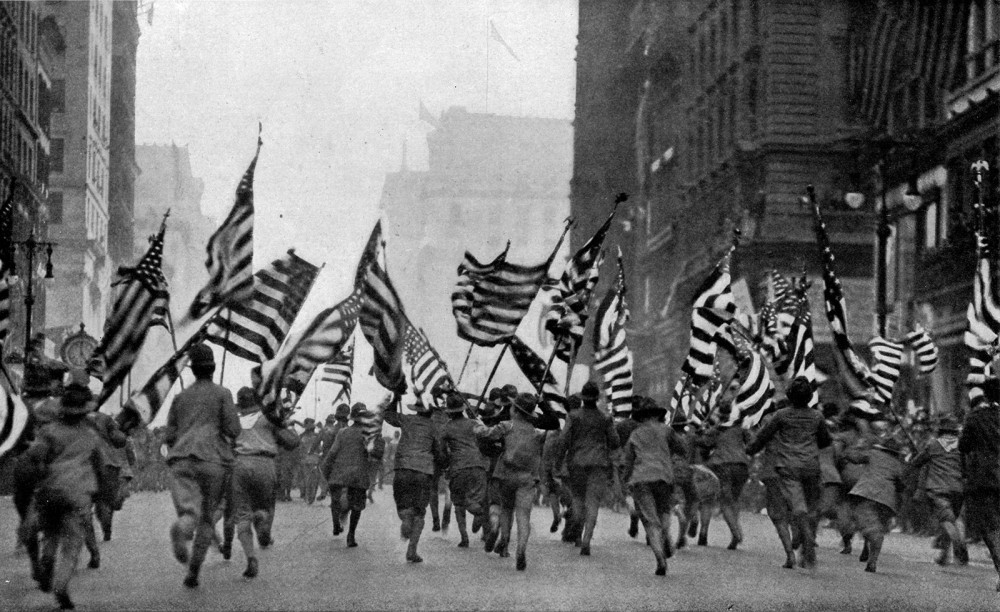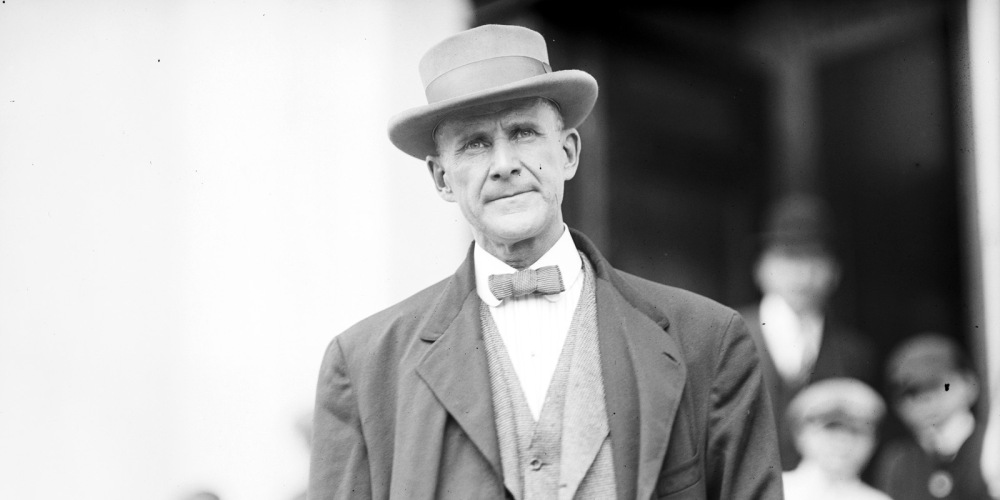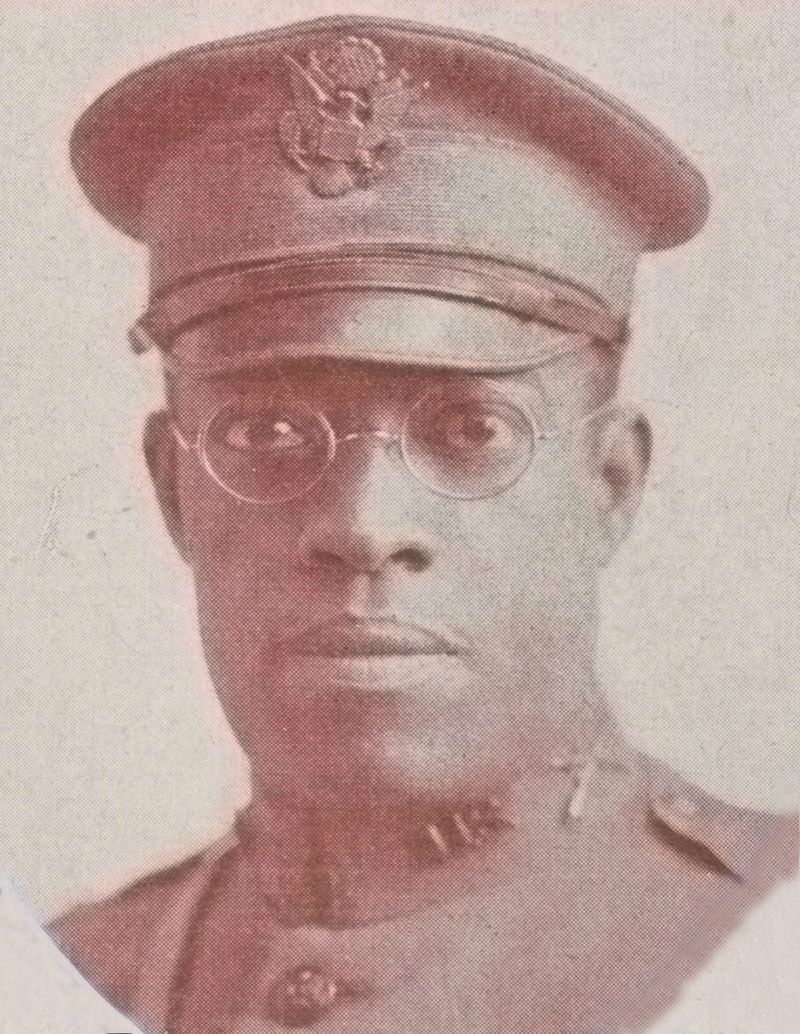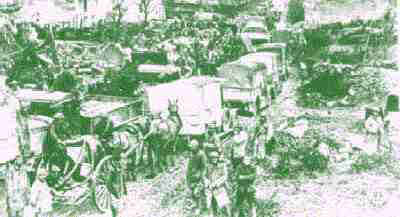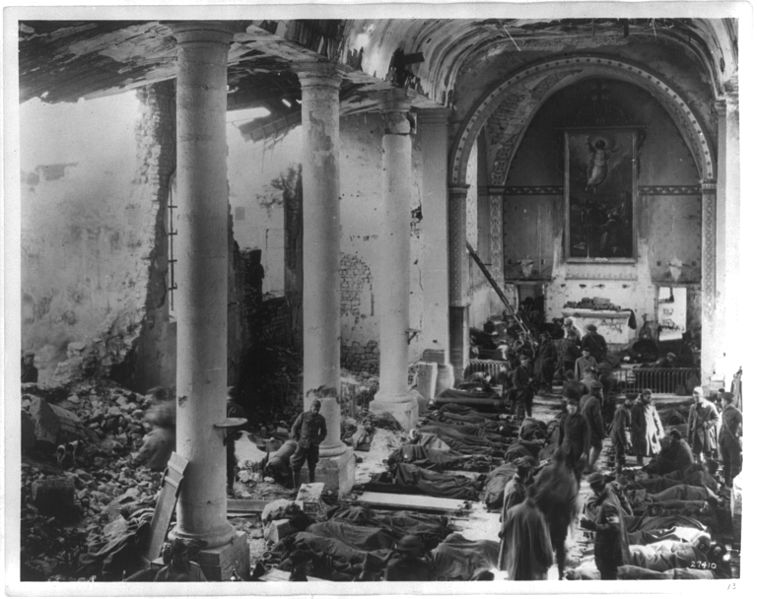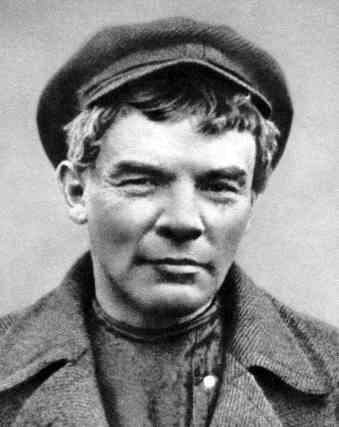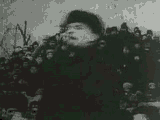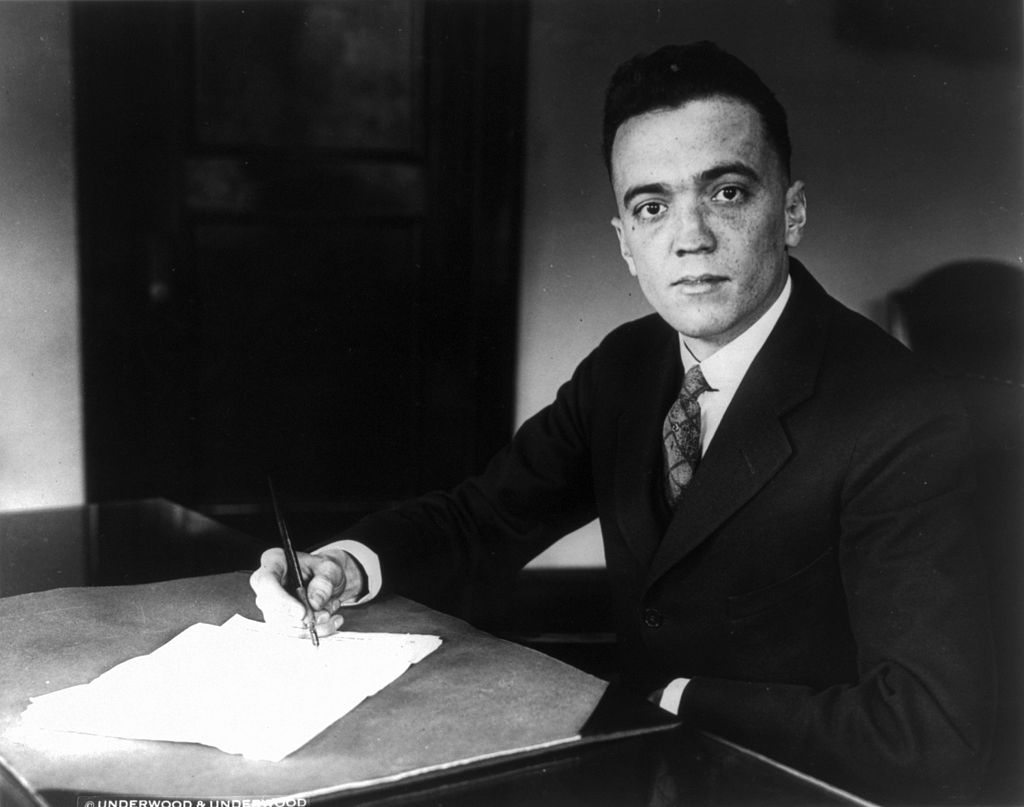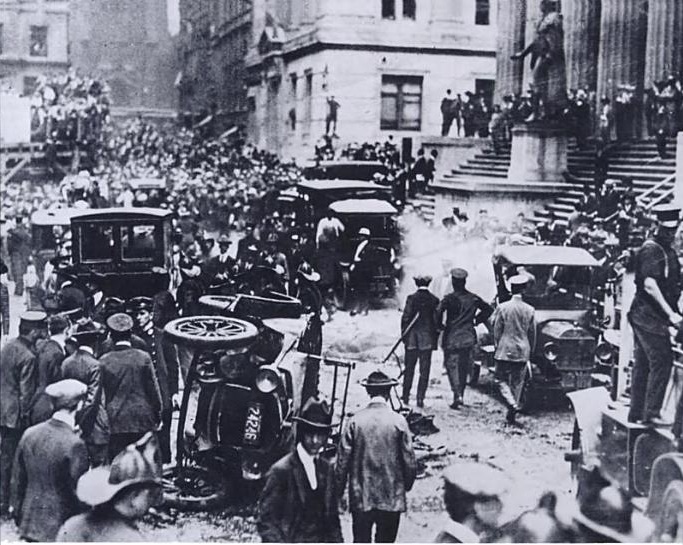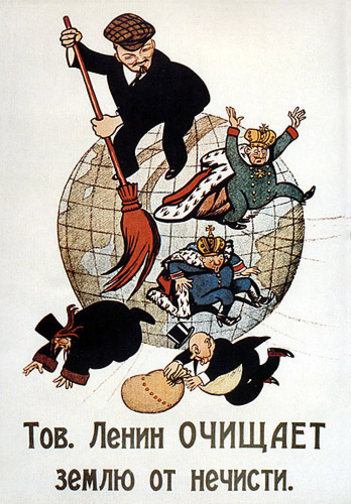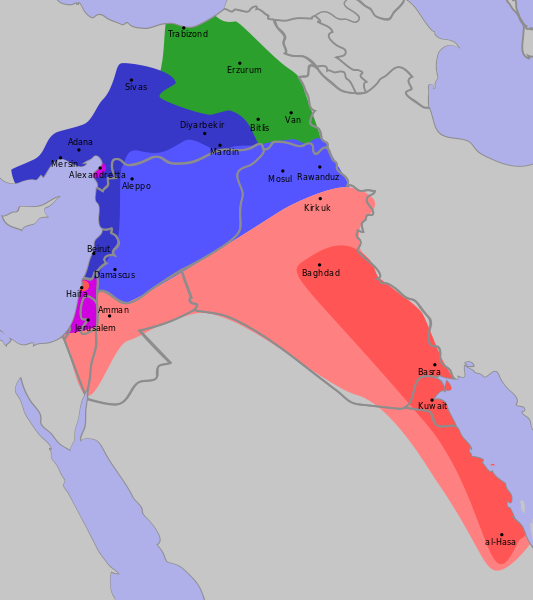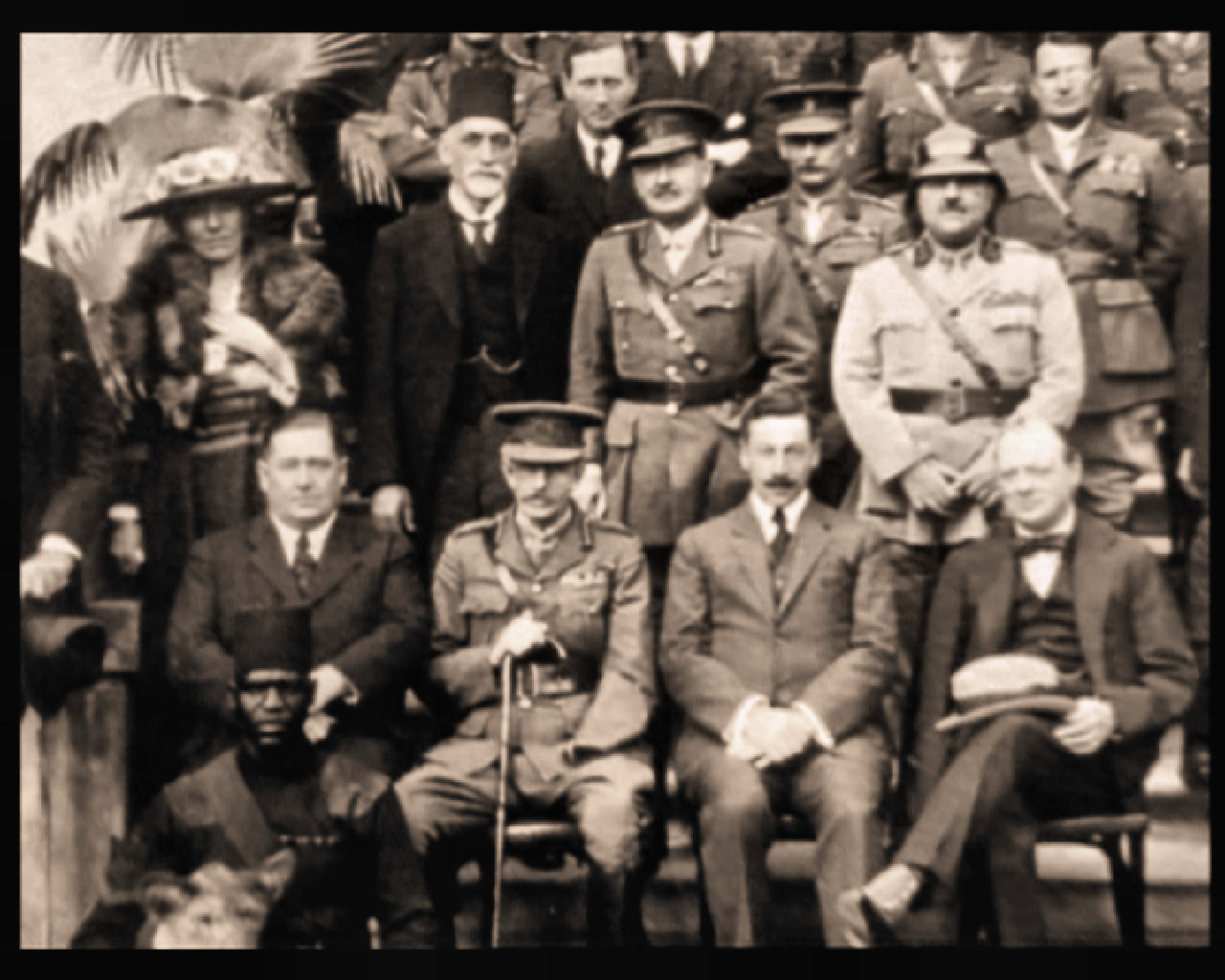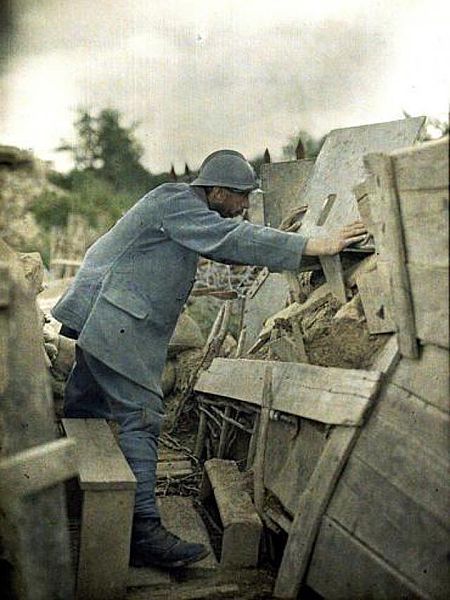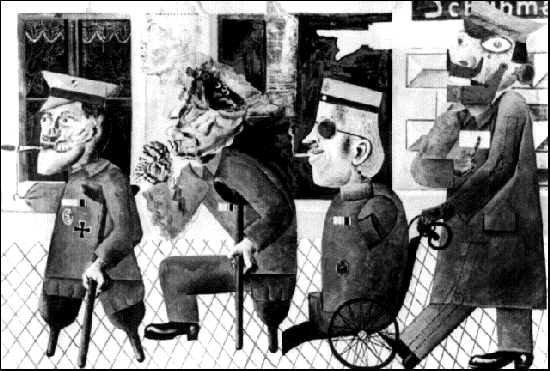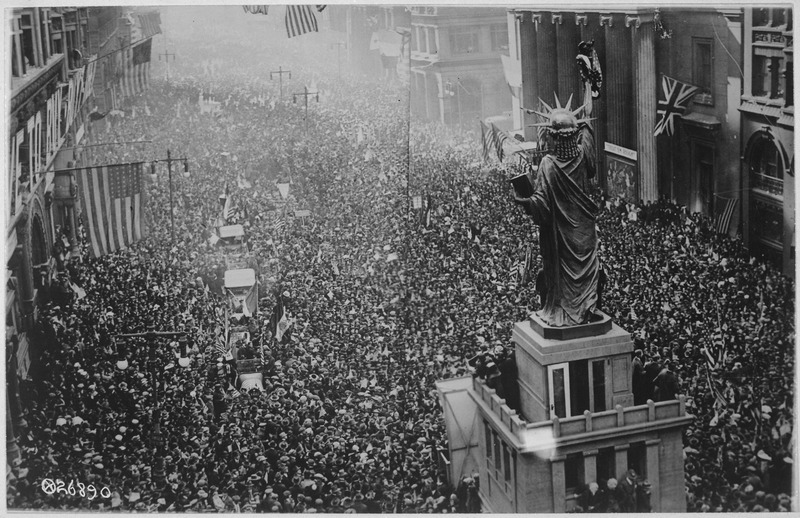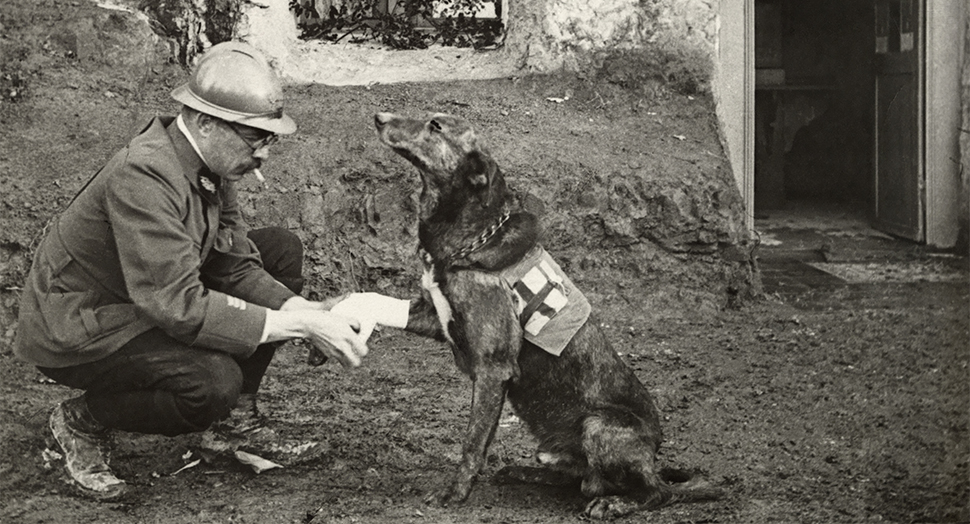“You will be home before the leaves have fallen from the trees.” — Kaiser Wilhelm to German Troops, August 1914
Historians often date the start of the 20th century to the Great War of 1914-1918 rather than 1901 because of its profound impact on creating the modern world. After killing nearly 10 million soldiers in a grinding conflict, its unsatisfactory conclusion caused World War II, contributed to the 1930s Great Depression, and remapped the Middle East, creating Turkey, Israel, Syria, Lebanon, and Iraq. Described then as the “war to end all wars” and later known as World War I, the Great War brought down four major monarchies, triggered the Russian Revolution — setting the stage for the Cold War between the Soviet Union and U.S. — and gave the Irish a window of opportunity to rebel against British rule, leading to independence for over ¾ of Ireland. It’s no surprise that historian Fritz Stern called the struggle “the first calamity of the 20th century, the calamity from which all other calamities sprang.”
In America, the war led to a bigger national government, racial violence, and a post-war backlash against radicals and dissenters culminating in an egregious subversion of the First Amendment. To top it off, a global flu pandemic in the last year of the war killed at least another 50 million people, probably more, ~ 7x more than COVID-19 among a population 4.5x smaller. The worst pandemic in modern history was layered atop what was, until then, the bloodiest war in human history. Many apocaholics are under the perpetual impression that the End Times are upon us, but if there was ever a time to harbor such fears it would’ve been World War I. Irish poet W.B. Yeats implied just that in his poem “The Second Coming” written at the end of the conflict. If tragedies and world-shaking events are any kind of omen, the End Times were well nigh upon us in the 1910s.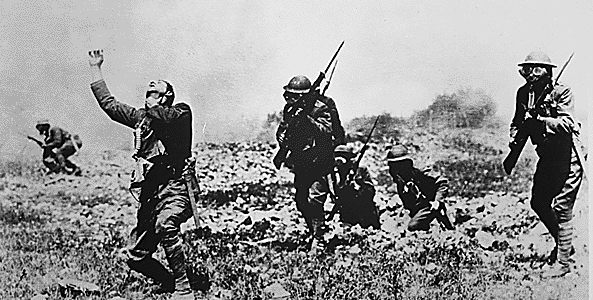
Underlying Causes
In the Long 19th Century (1789-1914), monarchies that had ruled Europe since the Dark Ages struggled to cope with industrialization, overseas colonization, and democratic rebellions kick-started by the French Revolution. The European scramble to colonize Africa, Asia, and the Middle East sparked an arms race, as colonial ambitions and nationalism exacerbated age-old rivalries and hatreds. All this despite the fact that Queen Victoria of Great Britain’s grandchildren led three rival countries: George V of Britain, Tsarina Alexandra of Russia, and their estranged cousin Kaiser Wilhelm II of Germany. There was nothing in their training or upbringing that prepared them to deal with modern problems. Nationalism raised the chance of conflict. Today, we take it for granted that people identify with their country more than, for instance, their town, county, state, region, church, profession, etc., but nation-states and the patriotism that go with them didn’t emerge until recent centuries.
Two matters complicated things further. One was Germany’s emergence under Otto von Bismarck and Kaiser Wilhelm as a consolidated nation, first as Prussia, and its growth into an industrial and military power rivaling Britain. This worried Britain despite Bismarck’s initial assurance that Germany and Britain were like an elephant and a whale — both formidable in their own right but no threat to each other. Germany’s emergence also made nervous its neighbors to the east and west, Russia and France. While the political vacuum in central Europe caused instability and flux in earlier centuries, the growing strength of Prussia/Germany in the 19th century threatened the balance of power held in place since the Congress of Vienna settled boundaries at the end of the Napoleonic Wars in 1815. They attacked Denmark and Austria in the 1860s and, in 1871, Prussia went to war with France, leading to an ongoing border dispute between the nations and an alliance between France and Russia to sandwich them in.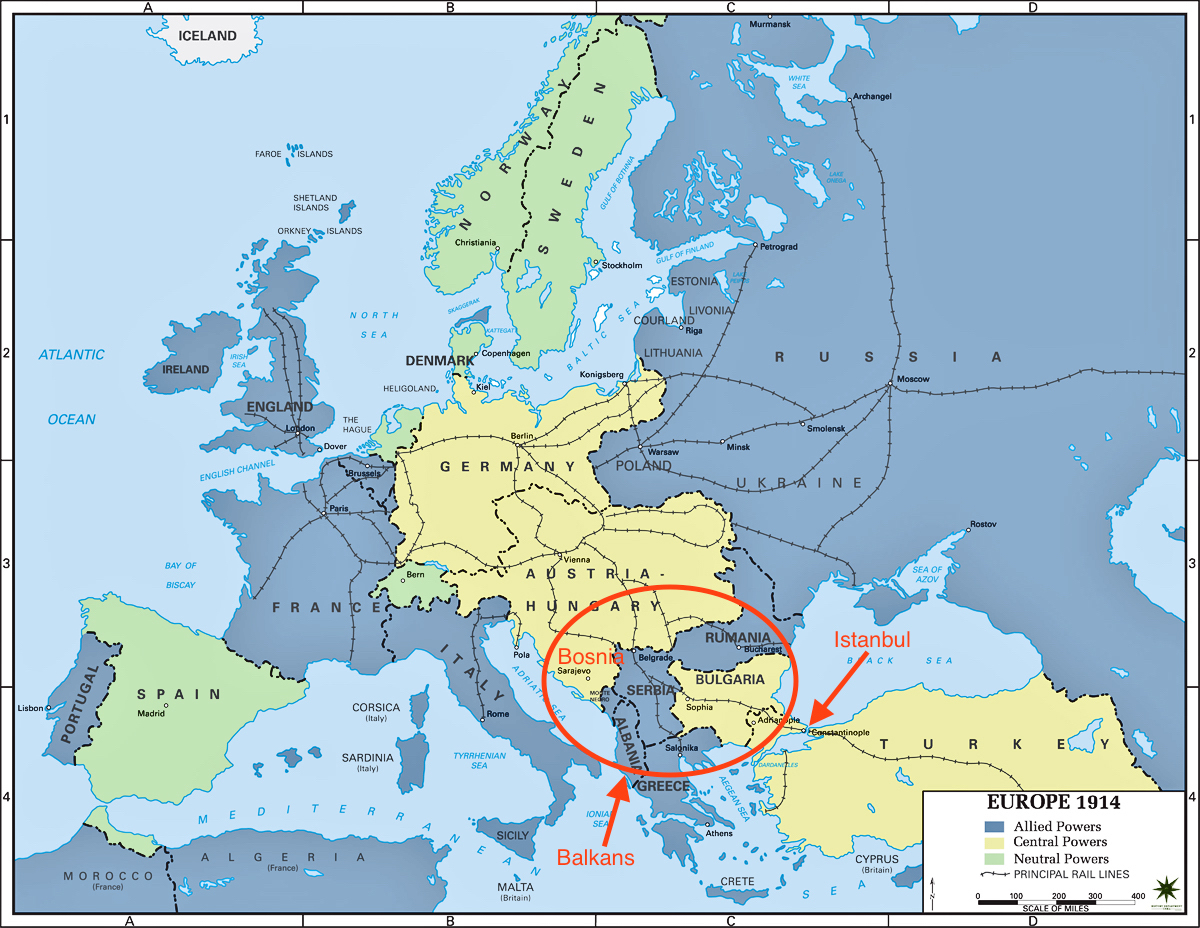
A second complication was the Islamic Ottoman Empire’s decline in southeastern Europe, Middle East, and North Africa. Its decline set off a flurry of small wars on the Balkan Peninsula resulting from nationalist hopes and ethnic and religious conflicts. If the Ottomans stood to lose control of southeast Europe (above), Russians didn’t want their fellow Slavs in the Balkans dominated by central Europeans, including the Austro-Hungarian Empire that bordered and coveted the region hoping to scoop up the Ottomans’ remnants. Russia meanwhile coveted Istanbul, to give them access to the Mediterranean from the Black Sea (map). Russia shipped grain exports via the Persian Gulf and feared Germany developing the Ottoman Empire as an export market. Serbia wanted independence but Austria thought Serbian independence would chip away at their empire by triggering like-minded movements in neighboring Bosnia and Herzegovina. Fueling the fire, the Balkans had a history of religious conflict between Roman Catholics, Eastern Orthodox Christians, and Muslims. On the historic fault line between Christianity and Islam, and riven with internal ethnic and religious tension, the Balkan chess piece was Exhibit 1A of what geopolitical analysts call a shatter belt.
Europeans coped with these continental-wide tensions by signing a series of seemingly defensive treaties with one another. We saw that Russia and France pledged to come to each other’s aid if either was attacked by Germany. German strategists, in turn, planned for a two-front war against France and Russia. The problem with the treaties was that there were so many interlocking agreements that it created a house of cards; one pulled card could bring down the whole house. Or, you could liken the situation to Jenga or KerPlunk. American President Woodrow Wilson’s Secretary of State William Jennings Bryan — our old friend from the Cross-of-Gold failed presidential campaigns in Chapter 2 — understood the problem, as did others. Bryan tried to arrange for “cooling off treaties” (similar to modern parents’ timeouts) should the house of cards start to collapse, but to no avail.
Looking back, a meltdown seems inevitable, but from their perspective going forward, treaties provided stability. Each country thought of itself as defending its own interests, not aggressively expanding. Maybe more wars would’ve started earlier without the treaties for all we know. But, by 1914, the stabilizing treaties were subject to the Law of Unintended Consequences and had a reverse destabilizing effect. If you’ll pardon one last metaphor, Europe was a powder keg.
The Powder Keg Ignites
The spark that lit the keg came in the Balkans (SE Europe) where Serbia, fresh off its independence from the Ottomans, didn’t want to turn around and be swallowed up by Austria-Hungary the way Bosnia had in 1908. Austria, in turn, worried that Serbian nationalism would embolden Slavic peoples elsewhere in its realm to seek independence. In 1914, Bosnian-born Serb nationalist Gavrilo Princip, working for a group called the Black Hand, shot and killed the heir to the Austro-Hungarian throne, Archduke Franz Ferdinand, along with his pregnant wife Sophie, Duchess of Hohenberg.
Princip was one of six people hired to assassinate the royal couple when they visited neighboring Sarajevo, Bosnia to inspect troops. The Black Hand had tried to kill the Archduke’s uncle, Austrian emperor Franz Joseph, three years earlier. Ironically, the Archduke was friendlier to the idea of Serbian autonomy than his uncle, but Princip either didn’t realize that or didn’t care. The crime triggered a chain of events that resulted in the biggest and worst war in modern history up until that point.
In the ensuing July Crisis Austria cracked down hard, taking it out on the Serbian population as a whole rather than treating the Black Hand as a criminal organization. Indeed, the Serbian army and intelligence were behind the Black Hand. While not letting Serbia take part in the investigation, Austria issued an ultimatum demanding that Serbia cooperate in apprehending the perpetrators, then didn’t give them long enough to comply. Instead, Austria just impatiently attacked in late July. Really, Austria-Hungary was using their Archduke’s assassination as a pretext, or plausible excuse, to consolidate their power in the Balkans and snuff out independence-minded nationalism there.
In early August, Russia came to Serbia’s defense while Austria-Hungary sought Germany’s aid in fighting Russia and got it. Per their arrangement, France hopped in against Germany to help Russia. Germany moreover hoped to secure Belgium and Poland to secure its dominant status in central Europe. Britain couldn’t bear to stand by and let others fight and presumably gain colonial holdings at her expense, so it joined the other Entente Powers (Allies) against the Central Powers of Germany, Austria-Hungary and the Ottoman Empire (later on, Italy joined the Allies). Germany’s invasion of neutral Belgium, violating the 1839 London Treaty, was Great Britain’s pretext for joining the war with France and Russia against Germany and Austria-Hungary.
The house of cards had collapsed; the powder keg was exploding; the Jenga blocks were in a heap. There were last-ditch attempts at peace talks but Germany feared Russia would only grow stronger as it built out its railroads and wanted to attack them simultaneously with, or just after, a quick strike on Belgium and France. Germany’s Schlieffen Plan of fighting a two-front war called for taking care of the Western Front first, then turning on Russia. (Some military strategists call the idea of a stronger nation going to war with a weaker one before it strengthens Dynamic Differential Theory.) The plan was years in the making and they wanted to put it in motion before it was too late. Germany figured that Russia was still weak from its defeat at the hands of Japan nine years earlier on its Pacific coast.
But there were deeper underlying reasons for war beyond the practical expediency of plans, treaties, and assassinated leaders. Historian Frederic Morton wrote that “the madness of July 1914 was like the acute phase of a chronic illness that had afflicted Europe increasingly since the start of the Industrial Revolution.” Not only did governments struggle with modern problems, but many people felt a yearning for some collective identity, with their old regional ties to villages, guilds, and churches weakened by modernity and nationalism. War provided that collective cause. In 1913, a year prior to the war, Germany’s most popular almanac contained the following poem, the title of which, “Eine Sehnsucht aus der Zeit,” translates to “A Longing For Our Times:”
In the wealth of peace we feel the deadliest dread.
We are bereft of prowess, mission or direction,
And long and cry for war.
Such jingoism carried over to other artists and intellectuals, like composer Claude Debussy in France, author Thomas Mann in Germany, composer Arnold Schoenberg and philosopher Ludwig Wittgenstein in Austria — all of whom were swept up by war fever in the summer of 1914. Another Austrian, psychoanalyst Sigmund Freud, wrote that “For the first time in thirty years I feel myself to be an Austrian.” Gavrilo Princip had uncorked a continental-wide pressure valve.
Each country saw God as on its side and had told itself stories for years about their ethnic superiority over their neighbors. Some German soldiers even looked for tails on dead Russian soldiers, having been taught in school that Russians were subhuman primates. No one envisioned a long, drawn-out stalemate because everyone figured they’d win quickly and easily. Instead, the conflict lasted four years and spread around the globe.
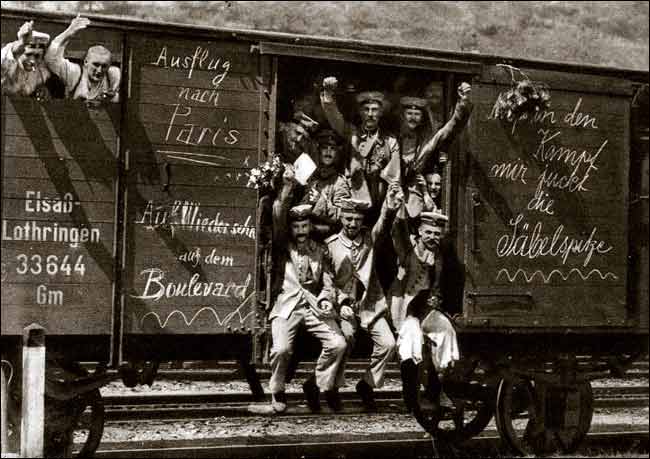
German soldiers on the way to the front during early World War I (1914). Messages on the car spell out (approximately): “Trip to Paris,” “See you later on the boulevard,” and “my sword tip is itching.”
As its later name World War I suggests, the Great War went global, including East Asia, Africa, and the Middle East. With the help of troops from Australia and New Zealand, Britain and France tried to clear a route to their ally Russia through the Dardanelles that, together with the Bosporus, form the Turkish Straits between the Mediterranean and Black Sea (see map below). They hoped to take Ottoman-controlled Istanbul after an amphibious landing at Gallipoli. British First Lord of the Admiralty Winston Churchill stubbornly ordered a futile land invasion after the initial naval maneuver failed, costing nearly 50k lives over subsequent months. The Gallipoli Campaign ended in disaster for the Allies but helped embolden nationalism in the new country of Turkey. Take six minutes to watch this military overview, that will orient you geographically and give you a feel for how the conflict between Serbia and Austria escalated into a broader war:
Industrialized War
Germany wasn’t able to finish off France quickly, as the Schlieffen Plan called for, so they had to fight a two-front war. After German troops plowed through Belgium, ruthlessly destroying villages and harming civilians in an attempt to stay on a tight schedule, France halted their advance outside Paris, along the Marne River. They’d had the French on the run, but troops from the capital city raced to the front in taxis to stop German forces and push them back. As the ensuing First Battle of the Marne showed, defense would have a big edge over offense in the Great War. Machine guns and field guns (rapid-fire artillery), including the French 75mm, allowed entrenched defenders to mow down aggressors almost at will. Germany’s standard-issue machine gun was the water-cooled, belt-fed 7.92mm MG 08, based on American Hiram Maxim’s influential recoil-operated Maxim Gun (1884). Firing 500 rounds a minute with an accuracy range of 3500 meters when mounted, the MG 08 was known to the British as the “paintbrush of the devil” and to the French as the “lawn-mower” or “coffee-grinder.”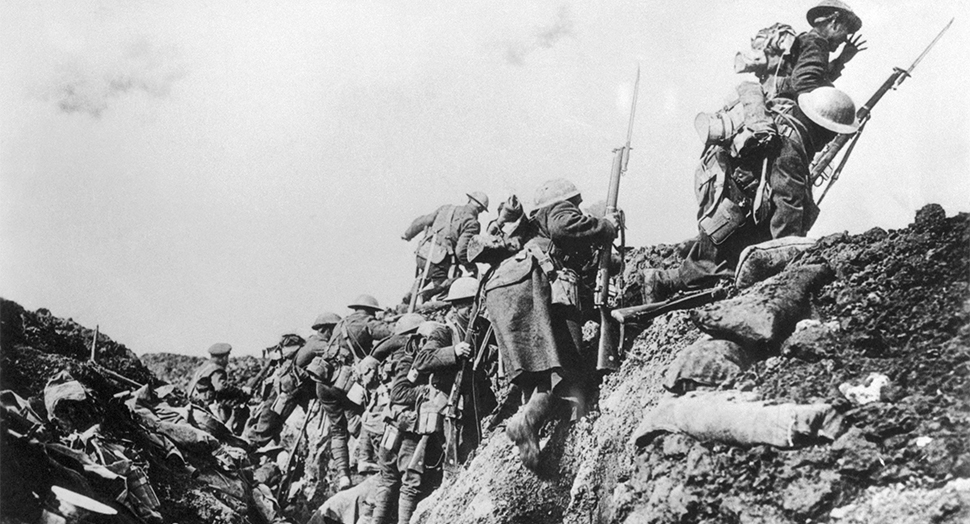
In response, armies dug trenches and shot mortar shells and lobbed grenades into each other’s ditches and later fired explosives with grenade launchers. Those who dared to go “over the top” into No Man’s Land between the trenches were usually shot and those caught on barbed wire in between were used for weeks as target practice. Above are Canadians going over the top for the Allies. There were different types of trenches, from fancier, multi-level trenches connected by underground tunnels, to larger supply trenches behind the front lines. Often, they were built in a zigzag formation to make them harder to attack from the air or opposing trenches. Soldiers lived and slept amidst their own refuse in all types of weather, surrounded by rats and corpses, hoping shells wouldn’t explode near enough to tear their limbs or faces off. Light artillery could obliterate bodies in trenches but the 75mm shells weren’t powerful enough to destroy the trenches themselves and force enemy troops to advance or retreat.
The war at least advanced the science of prosthetics. Rats that fed on corpses grew to the size of cats and soldiers did everything they could to kill them with bayonets or club them. Lice spread fever among the soldiers. Shell-shocked soldiers, suffering from what we’d now call post-traumatic stress disorder (PTSD) or called “soldier’s heart” in the Civil War, struggled for years to overcome the trenches’ horrors. In the near term, they were sometimes sent back to infirmaries to weave baskets — thus the term basket cases. Dogs kept vermin under control in the trenches, relayed messages, and provided comfort in their dying minutes to soldiers deemed hopeless in the triaging of casualties. Pressured by impatient politicians and citizens back home, generals ordered near-suicidal charges over the top but the lines along the Western Front, stretching from the North Sea to the Swiss border, moved back and forth only a few miles a year.
Assertiveness only invited death on a massive scale. More than other battles, Verdun and the Somme came to represent the “mud, blood and futility” of World War I. They both lasted for months in 1916, midway through the war, and were the first battles in world history with over a million casualties. At the ancient French fortress in Verdun, German Chief of Staff Erich Von Falkenhayn promised Kaiser Wilhelm II that he’d “bleed the French white” [dry] through a battle of attrition. The Kaiser’s son, Prince Wilhelm, whom the English called “Little Willie” or the “Butcher of Verdun,” led German forces. The French lost 27k at Verdun in one day and the battlefield had the highest number of casualties per square yard known to military history. French 75mm artillery helped protect Verdun as they shot off a thousand field guns (250 batteries) at a time round-the-clock for nine months straight, pummeling German troops with over 16 million rounds. African-American boxer Eugene Bullard (aka the “Black Swallow of Death”) volunteered for France and was wounded at Verdun. He said that he wasn’t surprised by how many people were killed, but rather that anyone there survived.  Britain’s “Big Push” in the Somme River Valley, intended to relieve French troops at Verdun by drawing off German troops, was equally tragic. Germany anticipated the offensive and dug in, supplying a vast network of underground tunnels and rooms connecting their trenches. On the first day alone, mostly in the morning, the British suffered 60k casualties. German MG 08 machine guns eviscerated young Brits rising up out of trenches into No Man’s Land overloaded with heavy packs of water, ammunition, grenades, picks, and shovels. Four-and-a-half months and over a million casualties later, the Western Front had budged six miles east for a pyrrhic Allied “victory.” Future fantasy writer and 2nd Lieutenant J. R. R. Tolkien was lucky to survive the Somme, though he suffered from the trench fever carried by lice and his ordeal influenced Lord of the Rings (1937-49).
Britain’s “Big Push” in the Somme River Valley, intended to relieve French troops at Verdun by drawing off German troops, was equally tragic. Germany anticipated the offensive and dug in, supplying a vast network of underground tunnels and rooms connecting their trenches. On the first day alone, mostly in the morning, the British suffered 60k casualties. German MG 08 machine guns eviscerated young Brits rising up out of trenches into No Man’s Land overloaded with heavy packs of water, ammunition, grenades, picks, and shovels. Four-and-a-half months and over a million casualties later, the Western Front had budged six miles east for a pyrrhic Allied “victory.” Future fantasy writer and 2nd Lieutenant J. R. R. Tolkien was lucky to survive the Somme, though he suffered from the trench fever carried by lice and his ordeal influenced Lord of the Rings (1937-49).
For many years, historians blamed British leadership with their “donkey and lions” take on the Somme campaign — that donkeys (asses) in the military brass needlessly sent courageous soldiers (lions) to their deaths. Impatient citizens and politicians back home wanting aggression and “results” were indirectly to blame, as well. However, the British learned from their mistakes and fought more effectively in the trenches and more carefully and cleverly in No Man’s Land after 1916, using leaner, quicker formations and “creeping barrage” that kept pace with advancing infantry.
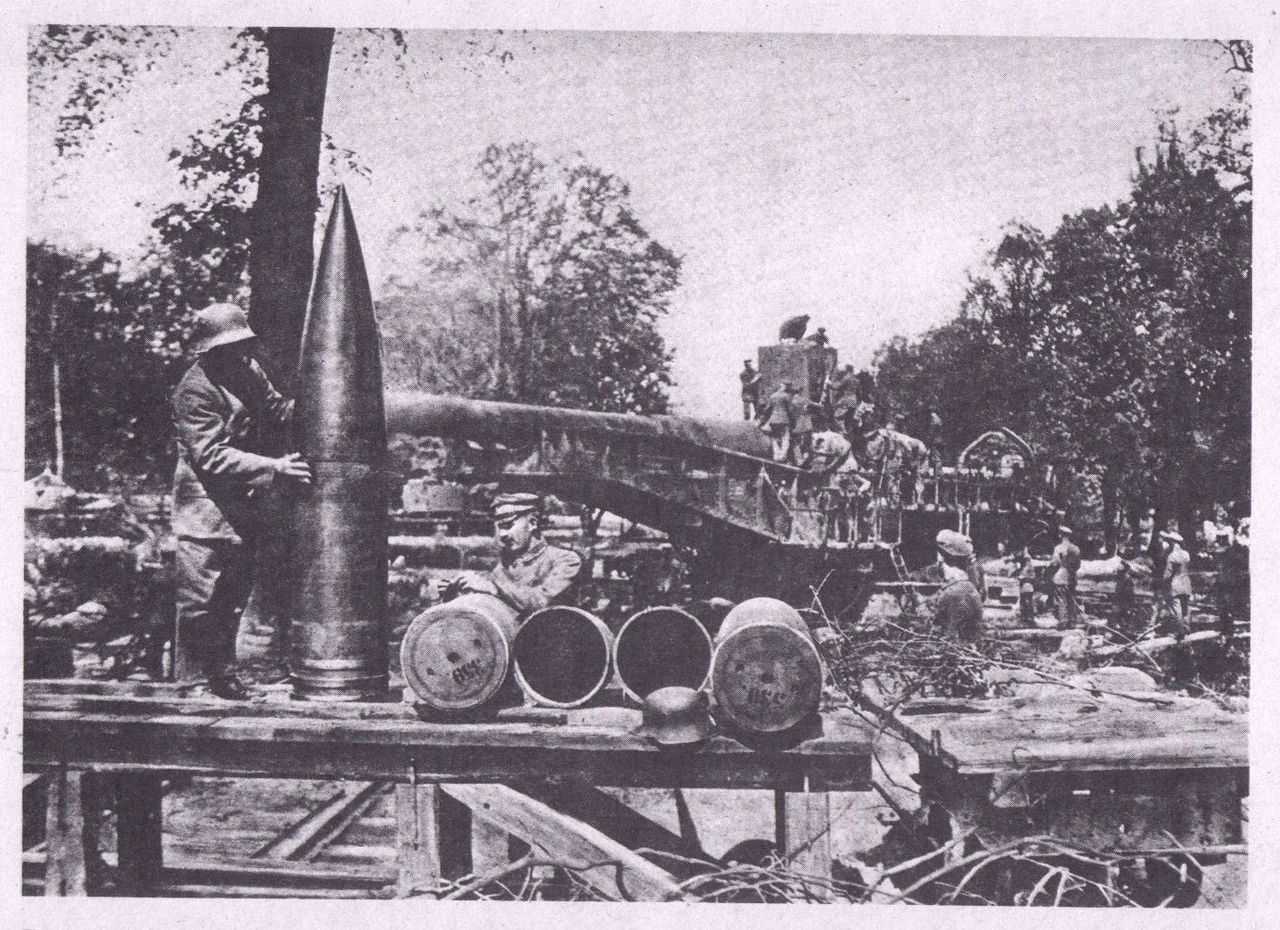
German 38er Langrohr Granaten “Long Max” Railroad Gun With 38cm Shells Fired the Opening Salvos @ Verdun
Industrial war killed on a scale unprecedented in human history. In 1917, by setting off 19 mines under the trenches simultaneously, the Allies killed 10k Germans at once near Messines, Belgium. After spending over a year laying the mines, they scheduled the explosion for a 3:10 a.m. shift change to double the casualties. The Messines explosion left a massive crater and the explosion was felt and heard as far away as London. The world hadn’t seen carnage on this scale since the Taiping Rebellion rocked southern China in the mid-19th century, and that was spread out over more years (1850-64).
Weaponry advanced in an attempt to break the stalemate. Tanks, so-named because they initially resembled water tanks, emerged gradually as a way to safely venture into No Man’s Land. Armored vehicles applied caterpillared wheels to gain traction on muddy battlefields (Benjamin Holt patented “crawler” tractors with continuous tread tracking in 1904).
Soon there were chemical weapons in the form of arsenic and various gases (e.g. phosgene, chlorine) that peeled off the lining of inhaler’s lungs. Those lungs could be the perpetrator’s, though, if the wind reversed direction at the wrong time or if mustard gas lingered in low-lying areas like trenches after an assault. Gas attacks also caused blindness (temporary and permanent), as immortalized in the John Singer Sargent’s painting Gassed (1919).
Planes provided reconnaissance to study opponents’ troop movements, trenches, and armaments. Pilots soon realized they could drop bombs out of their planes and shoot each other as they reconnoitered, leading to the advent of dogfights. Engineers developed interrupter gears for the planes so that pilots could shoot out the front of the cockpit without having the bullets deflect off the propeller.
Eugene Bullard, the boxer, wasn’t the only American fighting before the U.S. entered the war. Ambitious young men and women, most well-educated and idealistic, volunteered as ambulance drivers and pilots. The Model T-driving American Ambulance Field Service included such notables as Walt Disney, actor Adolphe Menjou, and writers Ernest Hemingway, Edmund Wilson, Gertrude Stein, E.E. Cummings, and John Dos Passos. They ferried dead and wounded from dressing stations just behind the lines to hospitals.
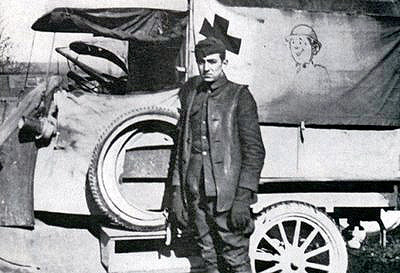
Walt Disney, American Red Cross Ambulance Driver in France During WWI & Ambulance Decorated By Him, fyeahwaltdisney.tumblr.com (WikiCommons)
American volunteer fliers formed their own unit within the French Air Service called the Lafayette Escadrille, so named for French General Marquis de Lafayette who fought alongside George Washington in the American Revolution. American pilots also volunteered with Britain’s Royal Flying Corps (RFC), their story immortalized in War Birds: Diary of an Unknown Aviator. When the U.S. later joined the war, its most famous fighter pilot, Eddie Rickenbacker, flew with the 94th Aero Squadron after changing the spelling of his last name from Rickenbacher to “take the Hun [German] out of it.” Many less famous German-Americans did likewise. Flying Aces with the most “kills” had star power, attracting the public’s attention more than infantry on the ground. With no parachutes and hastily constructed, flammable wooden planes, they had even shorter life expectancies than Earth-bound infantrymen, measured in weeks. In April 1917 alone, Britain lost 40% of its pilots. Most famous of all the Aces was German Manfred von Richthofen, alias the Red Baron.
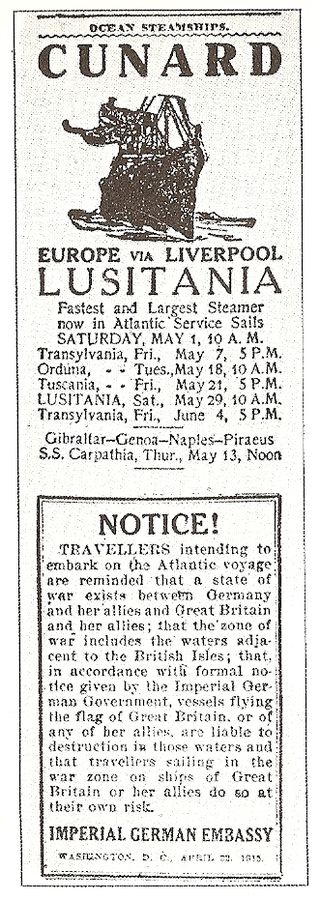 American Neutrality
American Neutrality
The American Ambulance Field Service, RFC, and Lafayette Escadrille notwithstanding, the U.S. had no direct role in the war in its first three years, from 1914-17. However, no one wanted the U.S. trading with its enemy, so Britain blockaded the North Sea to stop imports into Germany while Kaiserliche Marine U-boats (submarines) prowled the Atlantic to disrupt American arms shipments to Britain. Britain controlled the transatlantic cables, cutting all the lines between Germany and America, and fed Americans a steady diet of propaganda about German soldiers bayoneting Belgian babies and raping nuns. Germans tread lightly at first because they didn’t want the U.S. in the war, but eventually started attacking ships they suspected of sending armaments to Britain, declaring the area around the British Isles a war zone (right).
America stayed neutral but manufactured and sold weapons, including poisonous gas, while Wall Street bankers loaned to all the belligerents. Britain’s First Lord of the Admiralty, Winston Churchill, deliberately lured U.S. ships into submarine-infested waters to worsen German-American relations. In 1915, Germany sank the English RMS Lusitania off the Irish coast with 128 Americans on board. They suspected that the British and Americans were hiding goods in the hold of the passenger liner, and Germany’s American embassy even posted warnings in New York papers directly below Cunard Line advertisements (left) warning that they’d sink any ship carrying contraband in waters adjacent to the British Isles. The optional video above shows passengers boarding the ship.
The U-20 sub didn’t fire a warning shot to save passengers out of fear that they’d be sunk themselves. Germany argued, correctly as it turned out, that the reason the explosion from their torpedo was so violent and the ship sank so quickly, was that it was weighted down with weapons. Despite the Lusitania’s sinking, most Americans still opposed entering the conflict. After Germany sank the passenger ferry Sussex on its way from England to France in 1916, President Woodrow Wilson demanded and received a promise from Germany called the Sussex Pledge to not attack any ships unless they first established contraband on board. That agreement held for a year, but Germany went back on its word in 1917.
 Ex-president Teddy Roosevelt harrumphed that America’s youth was missing a chance at combat, but Woodrow Wilson (D) won narrow re-election in 1916 over progressive Charles Evans Hughes (R) on a promise to keep America out. Even a year after the Lusitania sinking, Wilson’s winning campaign slogan was He Kept Us Out of War. Despite the submarine attacks, Americans weren’t even clear as to which side they favored. By 1914, there were as many German-Americans in the population as Anglos and millions of Irish-Americans who hated England (2020 regional [national] ancestry map). Germans had enclaves in Midwestern cities like St. Louis, Milwaukee, and Cincinnati. But American bankers loaned more to the western Allies (France and Britain) than Germany. The longer the war went on, the greater their stake was in the Allies winning, so that they’d get their money back. J.P. Morgan loaned over $500 million to the French and British and a German-American assassin tried unsuccessfully to kill him. War critics pointed to the role of weapons manufacturers and Wall Street bankers like Morgan, whom they later maligned as “merchants of death.” Automaker Henry Ford said that only militarists and money-lenders profit from war. Overall, by 1916, the U.S. was still neutral but not as evenly neutral as they were before the Lusitania sinking and increased loans to Britain and France. Americans were also involved in humanitarian efforts through the Red Cross and Commission for Relief in Belgium that aided the Allies and all the American volunteer ambulance drivers, infantrymen, and pilots served the Allies, not Germany. The U.S. poured over $6 billion in relief to Europe, Russia, and the Near East from 1914-1924.
Ex-president Teddy Roosevelt harrumphed that America’s youth was missing a chance at combat, but Woodrow Wilson (D) won narrow re-election in 1916 over progressive Charles Evans Hughes (R) on a promise to keep America out. Even a year after the Lusitania sinking, Wilson’s winning campaign slogan was He Kept Us Out of War. Despite the submarine attacks, Americans weren’t even clear as to which side they favored. By 1914, there were as many German-Americans in the population as Anglos and millions of Irish-Americans who hated England (2020 regional [national] ancestry map). Germans had enclaves in Midwestern cities like St. Louis, Milwaukee, and Cincinnati. But American bankers loaned more to the western Allies (France and Britain) than Germany. The longer the war went on, the greater their stake was in the Allies winning, so that they’d get their money back. J.P. Morgan loaned over $500 million to the French and British and a German-American assassin tried unsuccessfully to kill him. War critics pointed to the role of weapons manufacturers and Wall Street bankers like Morgan, whom they later maligned as “merchants of death.” Automaker Henry Ford said that only militarists and money-lenders profit from war. Overall, by 1916, the U.S. was still neutral but not as evenly neutral as they were before the Lusitania sinking and increased loans to Britain and France. Americans were also involved in humanitarian efforts through the Red Cross and Commission for Relief in Belgium that aided the Allies and all the American volunteer ambulance drivers, infantrymen, and pilots served the Allies, not Germany. The U.S. poured over $6 billion in relief to Europe, Russia, and the Near East from 1914-1924.
Moreover, Germany sabotaged American munitions production, setting off a massive explosion at Black Tom Island in Jersey City, New Jersey in July 1916 that could be heard as far away as Philadelphia, shattered windows in Manhattan and Brooklyn, killed five people (including an infant), and symbolically blew shrapnel into the Statue of Liberty, rendering Lady Liberty’s arm unable to usher tourists safely up into the still unused torch viewing area. Unfortunately for them, German spies were too busy blowing up U.S. and Canadian shipping and trying to stir up labor unrest to stop and buy a corner newspaper. If they had, they would have realized that Wall Street was about to cut off the Western Allies by 1917, frustrated at their inability to repay loans. Instead, Germany abandoned the Sussex Pledge and gambled on resuming submarine warfare in the Atlantic, this time unrestricted, hoping to starve out Britain by depriving them of coal, fuel, and food before they alienated the U.S. enough to join the war against them. German U-boats sank more U.S. merchant ships. In early 1917, American filmmaker Cecil B. DeMille made an anti-German movie called The Little American, helping to fuel pro-war sentiment. Germany was going for broke with the resumption of submarine attacks just as their chance of winning on the Western Front increased when Russia surrendered, ending the war on the Eastern Front. Germany was no longer caught in a pincer between Russia on the east and France and Britain on the west.
In January 1917, British intelligence executed a masterstroke. They intercepted and decoded a message from Germany to Mexico, later known as the Zimmerman Telegram, asking Mexico to invade the U.S. to reclaim Texas and the Southwest. The U.S. was already engaged in conflicts with Mexico during the 1910s — the Border Wars, including Pancho Villa’s raid on Columbus, New Mexico, were an outgrowth of the Mexican Revolution — which was likely yet another reason the U.S. was disinclined to send its heretofore small number of troops to Europe earlier than it did. Arthur Zimmerman’s idea was that with America preoccupied repelling Mexico, Germany could finish off Britain and then come to Mexico’s aid and Germany would later recognize Mexico’s claim to the Southwest after Mexico defeated the United States. Germany also invited Japan to join its proposed alliance with Mexico.
The British held the telegram until just after a series of German submarine attacks and slightly exaggerated its contents. Mexico never considered the ploy — President Venustiano Carranza and his military advisors all agreed the notion was ridiculous — but Britain delivered it to President Wilson in February, without letting on to Germany that they’d broken their code. Germany even had the audacity to use American telegraph lines to send the message to Mexico (Wilson had generously offered the cable to their embassy in 1916 during peace negotiations). The Zimmerman Telegram pushed Wilson further toward war and aroused Southerners, even if much of the public forgot about it within a few weeks. Wilson spoke no further about negotiations after the incident. On the heels of resumed submarine attacks in the Atlantic and the Zimmerman Telegram, he said, “a break we had tried so hard to prevent, now seems inevitable.” More important for Congress was the U-boat attacks, especially with some Americans dying on British cargo ships. In April 1917, Congress granted President Wilson a declaration of war against Germany. Animated Map
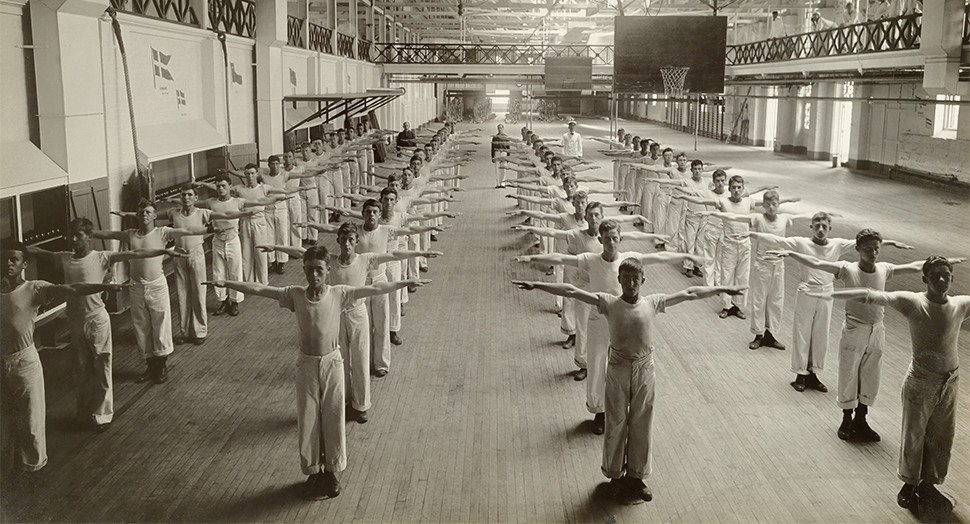
Sailors Training @ Aquidneck Island, Newport, Rhode Island, April 1917, Navy Department-National Geographic
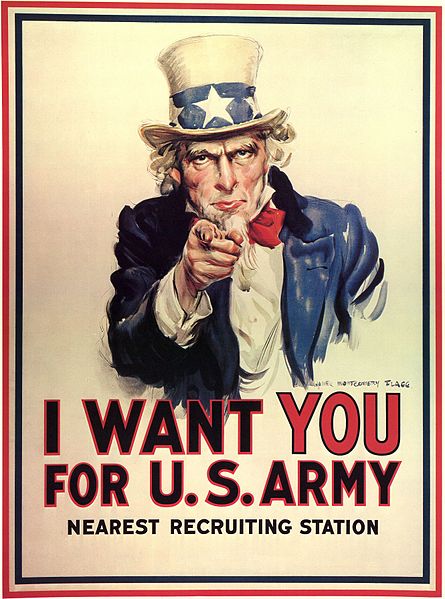 Over Here: Domestic Front
Over Here: Domestic Front
With Russia out of the war, President Wilson spun America’s defense of Britain and France as a war to save democracy. The military wasn’t on a wartime footing so it took them months to raise and train soldiers. The U.S. Army had no units larger than regiments and only 128k troops. It was basically a skeletal, 19th-century frontier force. In hindsight, Wilson should’ve listened to Republicans like Teddy Roosevelt and Henry Cabot Lodge who encouraged him to start building up the military years earlier. Wilson asked for a million volunteers but got only 73k, so he passed the Selective Service Act in May to institute a draft. Uncle Sam emerged gradually during the 19th century, based on the English John Bull, but the version that stuck is from 1917 (left). Having all boys of age register with the government then “selecting” some was intended to go over not so much as a draft as much as the government merely helping to facilitate volunteerism. The few drafts in American history, namely the Civil War, hadn’t gone well and their necessity sent a message that a given war wasn’t popular or meaningful enough to attract volunteers. 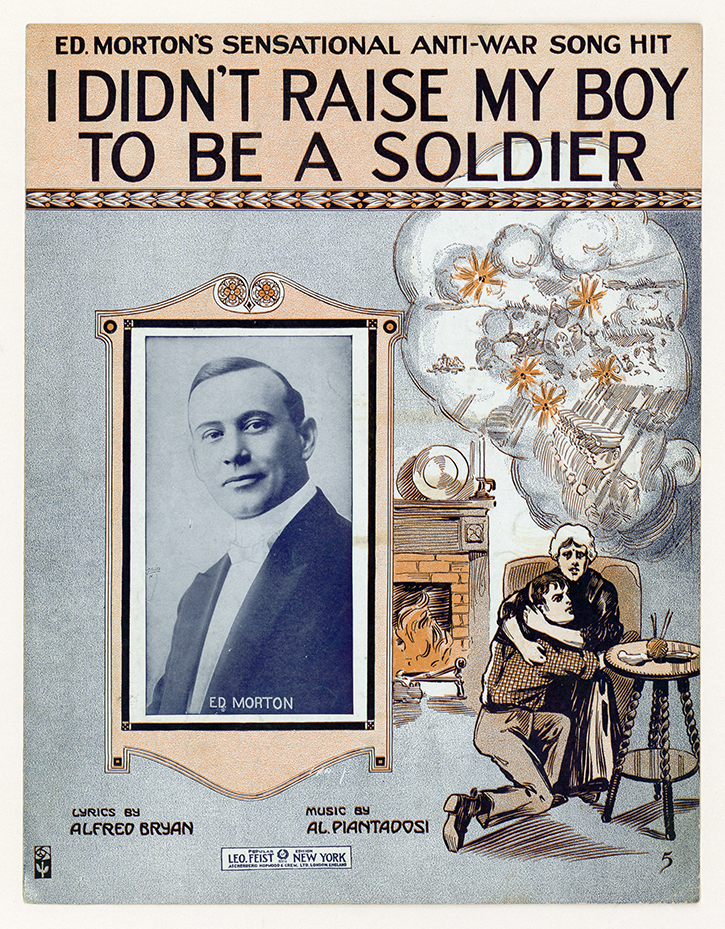
Sixty-four thousand conscientious objectors registered their reasons for not fighting and another three million “slackers” never signed up. Many of those that refused to serve went to prison. Many German and Irish-Americans opposed the war, along with labor leaders and congressional progressives like Robert La Follette (R-WI). The war was relatively unpopular in the rural South and among many religious leaders. Anti-war and pro-war songs came out of New York’s Tin Pan Alley that, before television, provided many Americans with news about current events.
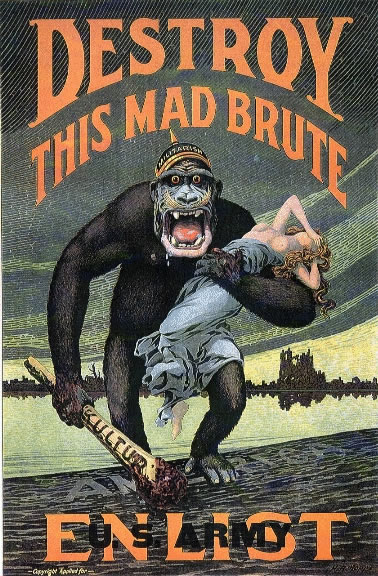 Unable to fully pique the public’s interest, Wilson hired journalist George Creel to promote the war effort and pitch the draft, saying it was good for American boys’ “heart, liver, and kidneys.” Creel’s Committee on Public Information (CPI) was, in essence, a propaganda office that swelled to over 100k employees. Creel had already worked for Wilson on his “He Kept Us Out Of War” 1916 re-election campaign and now turned his unique talents to promoting the war by demonizing Germany and justifying America’s entry. The CPI’s Red, White & Blue series and Loyalty Pamphlets explained Wilson’s ideological crusade on behalf of preserving global democracy. With posters appealing to ethnic rivalries, the government cajoled the public into financing the war through Liberty Bonds. If you went to the county fair, people dressed in red, white and blue offered bonds; at work, you were asked to put a portion of your check into bonds; at the movies, locals would rise during the four minutes it took to change reels to give patriotic speeches. Their general guidelines were carefully crafted by the government, but “Four-Minute Men” wrote speeches in their own words, lending them authenticity. Hollywood headliners like Charlie Chaplin, Mary Pickford, and Douglas Fairbanks promoted war bonds in public gatherings, while Hollywood cranked out anti-German war films. The government took the Philadelphia Liberty Bell on a cross-country whistle-stop train tour to raise funds and, according to Smithsonian Magazine, ¼ of Americans came out to see the iconic symbol of the American Revolution.
Unable to fully pique the public’s interest, Wilson hired journalist George Creel to promote the war effort and pitch the draft, saying it was good for American boys’ “heart, liver, and kidneys.” Creel’s Committee on Public Information (CPI) was, in essence, a propaganda office that swelled to over 100k employees. Creel had already worked for Wilson on his “He Kept Us Out Of War” 1916 re-election campaign and now turned his unique talents to promoting the war by demonizing Germany and justifying America’s entry. The CPI’s Red, White & Blue series and Loyalty Pamphlets explained Wilson’s ideological crusade on behalf of preserving global democracy. With posters appealing to ethnic rivalries, the government cajoled the public into financing the war through Liberty Bonds. If you went to the county fair, people dressed in red, white and blue offered bonds; at work, you were asked to put a portion of your check into bonds; at the movies, locals would rise during the four minutes it took to change reels to give patriotic speeches. Their general guidelines were carefully crafted by the government, but “Four-Minute Men” wrote speeches in their own words, lending them authenticity. Hollywood headliners like Charlie Chaplin, Mary Pickford, and Douglas Fairbanks promoted war bonds in public gatherings, while Hollywood cranked out anti-German war films. The government took the Philadelphia Liberty Bell on a cross-country whistle-stop train tour to raise funds and, according to Smithsonian Magazine, ¼ of Americans came out to see the iconic symbol of the American Revolution.
One bond drive turned tragic. The flu pandemic spread globally in the last year of the war, just as the U.S. entered. Ignoring what we now call “social distancing,” Philadelphia refused to cancel a downtown Liberty Bond parade. Cities were under pressure to fill bond quotas and the Philadelphia Inquirer urged people to get out: “Talk of cheerful things instead of disease…The [local] authorities seem to be going daft. What are they trying to do, scare everybody to death?” But with many doctors and nurses pressed into military service, the city’s 31 hospitals were overwhelmed and, within two weeks of the super-spreader parade, 4500 had died. Casket prices skyrocketed as “bodies stacked like cordwood” while rumors spread that the German-based Bayer company was complicit. Woodrow Wilson’s response to the worst pandemic in American history was simply to ignore it altogether, leaving it to local authorities to sort it out. He didn’t want the bad news to hamper the war effort and he likely initially thought it was just a strong strain of the regular flu that then killed ~ 10k every year (today 30-70k). Other cities had more time to prepare and local health officials flattened the curve by closing schools, shops, theaters, etc. Philadelphia developed herd immunity faster than St. Louis, but only at great cost.
It’s not unusual that Wilson would’ve assumed health was a local concern since the national government was smaller and no one at the time would’ve necessarily expected the president to take an active role.
But President Wilson expanded national power and influence elsewhere. The CPI’s propaganda inadvertently triggered a spate of vigilante justice against innocent German-Americans. With obvious ethnic connotations, Wilson said, “citizens of U.S. born under other flags have poured the poison of disloyalty into the very arteries of our national life. Such creatures of passion, disloyalty, and anarchy must be crushed out. They are infinitely malignant and the hand of our power must close over them at once.” Wilson’s American Protective League helped enforce support for the war, using Americans to spy on each other.
In many states, frankfurters became hot dogs, schools couldn’t teach German, and symphonies couldn’t play music by German or Austrian composers like Mozart, Beethoven, or Bach. Patriots tried replacing hamburger (Hamburg, Germany) with Salisbury steak but didn’t have any more luck than they did substituting freedom fries for french fries after France denied that Iraq had nuclear weapons in 2003. Iowa Governor William Harding forbade the state’s citizens from speaking German. In one absurd case, war supporters gathered and slaughtered German shepherds. The Washington Post applauded the vigilante murder of a German-American war protester and a jury clad in red, white, and blue acquitted the guilty mob. As we saw in Chapter 4, war against Germany also helped put Prohibition over the top as the temperance movement targeted German brewers like Joseph Schlitz, Frederick Pabst, and August Anheuser Busch, Sr. (Budweiser), making sure Prohibition wasn’t just aimed at hard alcohol. In keeping with the beer-and-Germany association, Anglos even gathered for “stein-breaking parties.” Wilson did nothing to discourage any of what amounted to the wholesale cultural destruction of a vibrant ethnic identity in the name of war and “yanking out the hyphen,” as in German-American. Meanwhile, the Justice Department photographed, fingerprinted, and interrogated German-Americans under a program led by 22-year-old agent J. Edgar Hoover, later a famous and long-time FBI director (more below).
In the most notorious subversion of the First Amendment right to free speech since the 1790s, the government outlawed opposition to the war and (for a while) journalists writing about the flu pandemic so as to not demoralize troops. They used the Post Office to censor anti-war mail. The Supreme Court heard the case of socialist Charles Schenk, arrested under the Sedition Act for mailing anti-war leaflets and handing them out in front of a munitions factory. The court ruled in Schenk v. U.S. that Schenk violated the 1917 Espionage Act by presenting a “clear and present danger” analogous to yelling fire in a crowded theater (as happened with a fire in Calumet, Michigan in 1913, killing 70 people). Schenk was in Philadelphia’s Socialist Party. Hollywood producer Robert Goldstein went to prison for three years for making Spirit of ’76, a movie about the American Revolution deemed unpatriotic by the Justice Department because the movie’s antagonists were British, America’s allies in the Great War. The judges feared that could inspire disloyalty and mutiny among U.S. troops. The Sedition Act also discouraged the media from reporting on the first wave of flu outbreaks at military camps. Amidst the hysteria, there were genuine terrorist cells within American borders, such as the operatives at Black Tom Island.
Though he obviously wasn’t a terrorist, the government sentenced Eugene Debs, leader of America’s Democratic Socialists, to ten years in prison and disenfranchised him for life. His crime? He said: “The rich start wars, and the poor fight them.” He represented himself in court and spoke for two hours, but lost. As mentioned in Chapter 2, he ran for president from prison in 1920 and garnered 3.4% of the vote — not bad for an inmate (he’d received 6% in 1912). He got “a roar of cheers” from fellow prisoners upon his release from the Atlanta Penitentiary in 1921, after President Harding commuted his sentence. Unlike Woodrow Wilson, who remained vindictive toward Debs, the Republican Harding invited him to the White House for a visit. From Washington, Debs returned to Terre Haute, Indiana, where a crowd of 50k welcomed him home with a marching band. The Democratic Socialists were more or less through as a political party, though. Russia’s Bolshevik Revolution in 1917 made their ideas too dangerous in the minds of those prone to slippery-slope reasoning. To wit: the dubious claim that democratic socialism inevitably leads to a communist dictatorship.
The government also staked out a larger role in the economy during the Great War. Wilson set up the War Industries Board which attempted, at least, to coordinate the industrial war effort. The WIB relied mainly on volunteerism, so it paled in comparison to the government’s efforts during WWII, when they compelled production. Nonetheless, they diverted coal to East Coast ports to ship overseas. When a telephone strike threatened to disrupt communication Wilson took over the industry, creating the government-run Ma Bell that monopolized lines until 1984. With industry pressured to produce munitions and men drafted into the army, jobs opened up in factories. Also, the war cut the U.S. off from cheap European labor. For the first time in American history, Blacks and Mexicans migrated to northern cities in large numbers at the beginning of the Great Migration. Southern lynchings and the emerging auto industry in Detroit also set minority migration in motion.
White soldiers returning home were upset to find minorities living in their cities, resulting in the worst racial violence America had seen for decades (though for Hispanic Americans the entire 1910s had been especially violent, AP). Among African Americans, so much blood was spilled in 1919 that it became known as Red Summer. It began when some Chicagoans stoned to death an African American swimmer for floating into white designated area of a beach on Lake Michigan (people feared that black skin color would attach to them). But there were also uprisings throughout the South, including Beaumont, Texas and the Elaine (Arkansas) Riot in which Whites killed over a hundred black sharecroppers protesting for better working conditions. But some of the worst violence was in northern cities like Chicago and Omaha. This optional graphic photo of African-American Will Brown’s charred remains in front of Omaha’s courthouse, surrounded by gloating onlookers, made the rounds on social media in recent years, used by both progressive anti-racists and far-right racists in the U.S. and Russia opposed to Barack Obama’s presidency. If there were any Americans naïve enough to think racism was just a southern problem, the Great Migration and Red Summer disavowed them of that notion. When Blacks and Mexicans migrated north, Jim Crow and Klan appeal migrated right along with them. That shouldn’t come as a surprise because Jim Crow-style segregation began in the North prior to the Civil War.
Another source of conflict was African-American soldiers returning home, who were less inclined than before the war to tolerate racial injustice. Red Summer resulted partly from white fear that black veterans’ service might entitle them to equality. This tension began during the war. The army drafted Blacks in disproportionately high numbers, as draft boards protected the sons of influential Whites and tried to shrink black populations in targeted areas. The races fought separately in Europe, with most American Blacks under French leadership, but they integrated training camps at home to avoid black concentrations in any one spot. That didn’t prevent riots between African-American troops and white civilians in East St. Louis and near Camp Logan, Texas, recently opened after the Houston Ship Channel’s construction.
The Houston incident started when white police officers assaulted a purportedly drunk black woman, dragging her out into the street in front of her neighbors partially clad. When passing black soldiers protested, they too were arrested. Later their corporal was shot at and beaten in the police station when he followed up to see what happened. Black troops from the 3rd Battalion 24th Infantry Regiment mutinied and stormed Houston with their rifles. The Camp Logan Riot caused 20 deaths overall and the largest court-martial trial in U.S. history in August 1917. The thirteen soldiers hanged weren’t allowed to appeal their convictions.
A similar incident almost broke out in Spartanburg, South Carolina when a gang beat up a soldier from the all-black 15th New York National Guard (later the 369th Regiment) for walking on the sidewalk. In that case, though, white soldiers from New York came to the black soldiers’ defense and the 15th’s leader, bandleader James Reese Europe, stood down to diffuse conflict. The 15th New York Guard later won fame as some of the first American heroes on the Western Front, earning the nickname “Harlem Hellfighters.” President Wilson, who reintroduced Jim Crow to Washington, D.C. and banned Blacks from working in the federal government, did no more to tamp down racism toward black soldiers than he did to discourage vigilante mobs from attacking German-Americans.
The Great War wasn’t all bad for African Americans. General John Pershing transferred them to French command, where they learned that not all Whites were racist. And they contributed to the victory, with dozens winning medals from France and America and Germans nicknaming the all-black 370th Regiment of Illinois “black devils.” One historian wrote that many Blacks during Jim Crow thought no more about white racism than “fish think about the wetness of water.” World War I taught black soldiers that different social relationships were possible and they came home expecting more from white Americans. Recent scholarship has also shown how black leaders recruited volunteers, sold liberty bonds, and publicized food conservation. This grassroots organizing and activism incubated future civil rights leaders. Soldiers from Illinois’ 370th Regiment also fought in Chicago’s Red Summer riots of 1919.
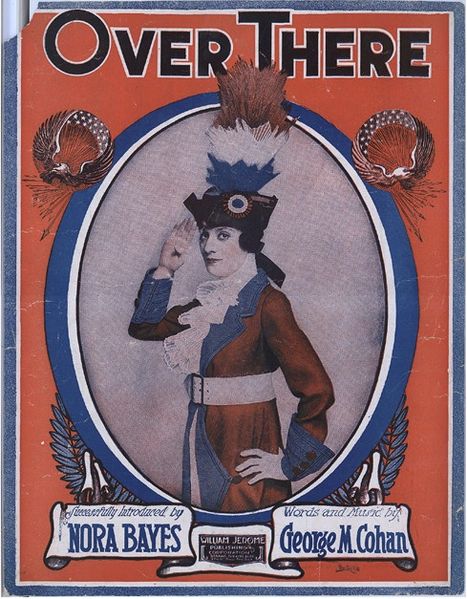 Over There: War Front
Over There: War Front
When American troops shipped overseas on packed boats to fight in 1918, the flu went with them. French ambulances and hearses greeted them at Brest in October 1918 to cope with those that had died or fallen ill during the Atlantic crossing. Influenza spread along the Western Front, where armies kept livestock near their infirmaries. The illness slowed a 1918 German offensive on the Western Front and complicated the American/Entente Powers counter-offensive.
The two million-soldier American Expeditionary Force (aka AEF or Doughboys) had big advantages and disadvantages compared to Europeans. On the plus side, healthy Doughboys weren’t worn down after three-and-a-half years of fighting and the arrival of fresh troops demoralized exhausted German troops, helping to blunt their 1918 offensive. The downside was that Doughboys were inexperienced and suffered huge casualties when their generals, led by John “Blackjack” Pershing, launched frontal assaults.
The tall, square-jawed, mustached Pershing had led four regiments of African-American Buffalo Soldiers in the Plains Indians Wars (Blackjack was the G-rated version of his nickname) and, in some ways, seemed stuck in the 19th century despite serving as an observer in the Russo-Japanese War (1905) and Balkans (1908) and leading troops against Mexican Pancho Villa in 1916. Mexico was where American soldiers earned the nickname Doughboys because of how they looked covered in light-colored dust. Pershing was grieving during the Great War as his wife and three young daughters all perished in a house fire in San Francisco’s Presidio in 1915 (his 6-year-old son survived). He was determined to not get bogged down in trench warfare, an admirable and reasonable goal, but he wanted his men to rely on rifles and bayonets, which wasn’t realistic. At first, Pershing didn’t grasp the importance of machine guns, tanks, and artillery in modern warfare. American troops weren’t always properly equipped and, like the recent War on Terror, the country didn’t fully prepare for their return home. The popular war anthem “Over There” by George M. Cohan proudly proclaimed that the Yanks wouldn’t stop “until the fighting was over, over there”:
The war between Germany and Russia on the Eastern Front was over by the time the Doughboys arrived, with Russian Bolshevik revolutionaries having sued for peace after they took over their country. With the Treaty of Brest-Litovsk in March 1918, the war ended on the Eastern Front. Ill-equipped Russian troops had been stretched thin along the thousand-mile front, divided between fighting Germany in the north and Austria in the south. With Russia defeated, Germany hoped that being able to focus all their efforts on the Western Front could win the war, especially in light of the Allies’ failed Passchendaele Offensive in Belgium in 1917. Yet Britain’s North Sea blockade was decimating Germany’s starving, disgruntled population. The year 1918 would likely tip the scales of this long, stalemated war in one direction or the other.
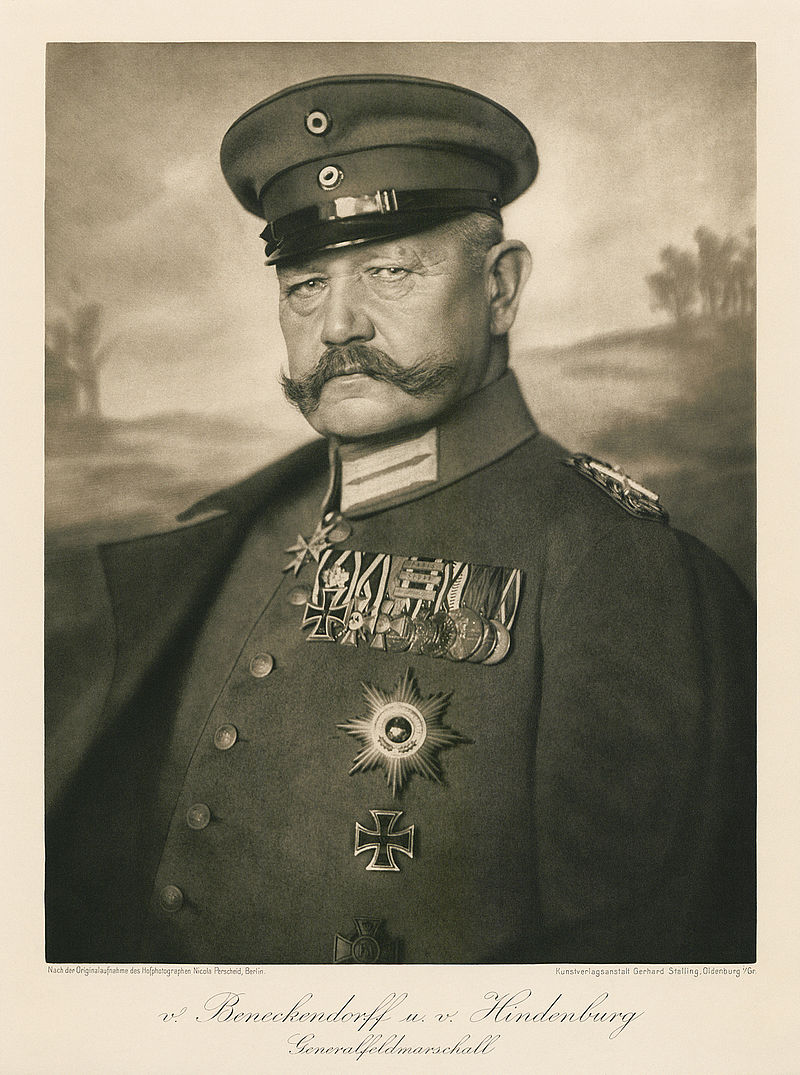 As mentioned, that was why Germany resumed submarine attacks on American shipping in the Atlantic, hoping to starve out Britain and wear down France before provoking the U.S. enough for them to enter the war. There were times in the war’s last year when it appeared that Britain had only a couple months worth of food left before facing severe hunger. Chancellor Theobald von Bethmann-Hollweg met with his generals at Pless Castle in January 1917 and planned an all-out assault on U.S. shipping to starve out Britain. This big gamble by Bethmann-Hollweg, Field Marshall Paul von Hindenburg (right), and Hindenburg’s deputy Erich Ludendorff to win the war in the west without America joining first might have worked if not for the Zimmerman Telegram misstep.
As mentioned, that was why Germany resumed submarine attacks on American shipping in the Atlantic, hoping to starve out Britain and wear down France before provoking the U.S. enough for them to enter the war. There were times in the war’s last year when it appeared that Britain had only a couple months worth of food left before facing severe hunger. Chancellor Theobald von Bethmann-Hollweg met with his generals at Pless Castle in January 1917 and planned an all-out assault on U.S. shipping to starve out Britain. This big gamble by Bethmann-Hollweg, Field Marshall Paul von Hindenburg (right), and Hindenburg’s deputy Erich Ludendorff to win the war in the west without America joining first might have worked if not for the Zimmerman Telegram misstep.
The French Army, like those everywhere, was beleaguered, dealing with mass desertions, court-martial executions, and resentment between soldiers and officers. Most couldn’t remember peace or even why the fighting started in the first place or even care about anything at that point but mere survival. Many soldiers across Europe had come to see their COs (commanding officers) and politicians as their real enemies instead of the soldiers across from them in the trenches. Officers lived in châteaus eating and drinking well in clean uniforms, more concerned with dodging gonorrhea than mortar shells. From time-to-time, they decided it was time for an offensive and ordered their men into near-certain suicidal charges that rarely resulted in territorial gain. Then it was back to the château. By 1917-18, it was every man for himself.
The Western Allies also resented how long it took the U.S. to mobilize after they joined the war, which took nearly a year. The French almost gave up hope Americans would ever arrive and considered negotiating peace. They also wanted American troops to fight under their command when they did arrive, but Wilson insisted that Blackjack Pershing lead the Doughboys. With the French army on the brink of collapse, Pershing had the leverage to demand autonomy and, moreover, this solo military engagement dovetailed with Wilson’s initial insistence that the U.S. stay out of any formal treaties or alliances with its allies. Maintaining America’s military independence and having that military play a big role in the war was essential to Wilson claiming a large role at the peace table and shaping the new postwar order. In World War I, America fought mostly alone on the side of Britain and France, the exceptions being African Americans fighting for France and Pershing coordinating with French General Philippe Pétain at the important Second Battle of the Marne.

“American Marines in Belleau Wood (1918)” by George Scott, Originally Published in the French Magazine “Illustrations”
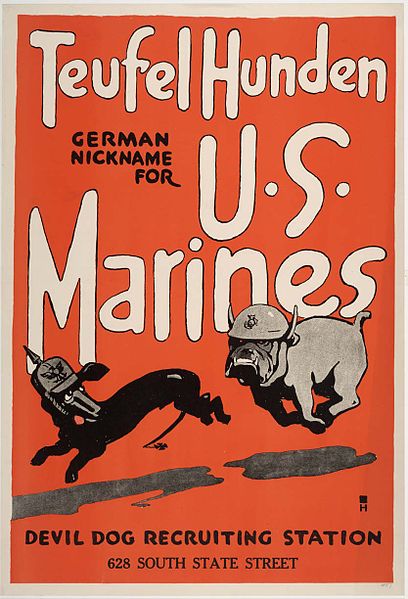 When the U.S. started fighting in 1918, they plugged the gap and helped stave off the German offensive on the Western Front. Meanwhile, a smaller group diverted to Italy to fight against Austrians. Germany had finally broken through the stalemate on the Western Front and was close enough to the “City of Lights” that Parisians could hear giant German guns and were fleeing to the country. During the Allies’ Spring Offensive, American Marines defended Paris at Château-Thierry and in the Battle of Belleau Wood, both as part of the Second Battle of the Marne. The Marines’ and Army 3rd Infantry Division’s hard-fought victory at Belleau Wood in June, at the cost of 5k lives, earned the Marines the complimentary nickname Teufel Hunden from the Germans, meaning devil dogs, while the 3rd Division came to be known as the “Rock of the Marne.” Most Doughboys carried the reliable and accurate .30-06 caliber, clip-loaded, bolt-action Springfield M1903 rifle fitted with a bayonet and they fought with both parts of the weapon in the heavily fortified, dense Belleau Wood hunting reserve near the Marne River. This three-week, close-quartered bloodbath was so intense that they couldn’t get in reinforcements, food, or medicine. Marines scavenged food and stale beer off dead Germans.
When the U.S. started fighting in 1918, they plugged the gap and helped stave off the German offensive on the Western Front. Meanwhile, a smaller group diverted to Italy to fight against Austrians. Germany had finally broken through the stalemate on the Western Front and was close enough to the “City of Lights” that Parisians could hear giant German guns and were fleeing to the country. During the Allies’ Spring Offensive, American Marines defended Paris at Château-Thierry and in the Battle of Belleau Wood, both as part of the Second Battle of the Marne. The Marines’ and Army 3rd Infantry Division’s hard-fought victory at Belleau Wood in June, at the cost of 5k lives, earned the Marines the complimentary nickname Teufel Hunden from the Germans, meaning devil dogs, while the 3rd Division came to be known as the “Rock of the Marne.” Most Doughboys carried the reliable and accurate .30-06 caliber, clip-loaded, bolt-action Springfield M1903 rifle fitted with a bayonet and they fought with both parts of the weapon in the heavily fortified, dense Belleau Wood hunting reserve near the Marne River. This three-week, close-quartered bloodbath was so intense that they couldn’t get in reinforcements, food, or medicine. Marines scavenged food and stale beer off dead Germans.
Just as when Germans got near the outskirts of Paris in 1914 in the First Battle of the Marne, they sent the fear of God into Parisians and even killed a few hundred with long-range artillery, but Germany was over-extended. French and British troops blew up bridges behind them and logistical challenges rendered them unable to capitalize on gains because their supply lines couldn’t keep up. Many hungry soldiers seemed more intent on helping themselves to food and wine in conquered French villages than advancing.
The Allies repelled Germany in the Spring Offensive. Then, at the Battle of Amiens in August 1918, Doughboys helped British and French-led troops break through German lines and sent them into retreat. Amiens was one of the first battles in history in which tanks were effective and signaled the end of trench warfare on the Western Front. At the beginning of what became known as the Hundred Days Offensive, Amiens turned momentum even more decidedly against Germany in the summer of 1918.
As part of the greater Hundred Days Offensive, the American Expeditionary Force fought Germans at Saint-Mihiel in the Meuse-Argonne Offensive, or “Battle of the Argonne Forest.” The relative suddenness of the four-day American victory at Saint-Mihiel seemed to vindicate Blackjack Pershing’s preference for mobile warfare over the trenches, but documents later revealed that the Germans were planning to retreat on their own before the battle. Like everyone else, German troops were weakened by influenza. They weren’t giving up, but they were at least reorganizing and tightening up their supply lines by moving east and they cancelled their draft to stop the influx of new flu-carriers. Despite their success, American troops in the offensive suffered from traffic congestion and straggling, exacerbated by flu victims retreating to the rear for care. Meuse-Argonne was the bloodiest foreign campaign in American military history, with 120k casualties and over 26k killed in 47 days — nearly half the number killed in Vietnam over an eleven-year period.
Meanwhile, in the Atlantic, U.S. ships crossed in convoys with aerial escorts near the shores, fending off German U-boats with depth charges. On land, the German army was in disarray by Fall 1918, having spent its energy. Hungry, disillusioned German civilians were pushing for a resolution. Domestic discontent hurt military morale. Hindenburg and Ludendorff told the Kaiser that the war was lost on September 29th, during the Hundred Days Offensive, and Ludendorff resigned. The Imperial German Navy mutinied in early November 1918, refusing to take part in a last-ditch suicidal offensive against the Royal Navy, and the mutiny spread to other parts of the military and civilian population.
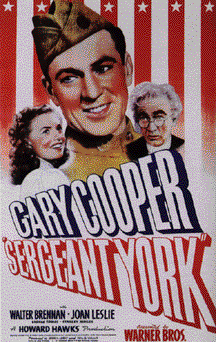 One sharpshooting Tennessean, Sergeant Alvin York, managed to take down an entire machine gun nest single-handedly, killing 28 Germans and capturing 132 POWs along with 32 machine guns. It was probably one of the two greatest individual efforts in American military history, along with that of Guy Gabaldon on Saipan in 1945. York was the most famous American hero besides Ace Eddie Rickenbacker and later the subject of a 1941 movie starring Gary Cooper. Heroic black soldiers like Freddie Stowers won medals like the Croix de Guerre (Cross of War) from the French Army and were honored posthumously in the U.S. by President George H.W. Bush in 1991.
One sharpshooting Tennessean, Sergeant Alvin York, managed to take down an entire machine gun nest single-handedly, killing 28 Germans and capturing 132 POWs along with 32 machine guns. It was probably one of the two greatest individual efforts in American military history, along with that of Guy Gabaldon on Saipan in 1945. York was the most famous American hero besides Ace Eddie Rickenbacker and later the subject of a 1941 movie starring Gary Cooper. Heroic black soldiers like Freddie Stowers won medals like the Croix de Guerre (Cross of War) from the French Army and were honored posthumously in the U.S. by President George H.W. Bush in 1991.
Don’t get lost in the details of battle names, but understand that the U.S. sacrificed a lot of troops given its indirect stake in the conflict and inflicted significant damage on Germany’s army, stopping their 1918 offensive and tipping the scale in the Allies’ favor (visualize this on a map in your head and, if that doesn’t work, look at a map or globe). Overall, the AEF lost 127k in just nine months of fighting, with around 320k casualties. It was the third-costliest war in U.S. history behind the Civil War and WWII. Of the 127k who died, 60k died of influenza. Teddy Roosevelt’s son, Quentin, died over France flying for the 94th Aero Squadron, shot in the head by German fighters and buried with full honors by the German military. The government offered soldiers $10k worth of life insurance before they went to Europe and it was said that victims “bought the farm” with the $10k. Seventy-thousand Doughboys inhaled mustard gas, which wasn’t always fatal but caused lingering complications. Hall of Fame baseball pitcher Christy Mathewson was among those afflicted. At least the U.S. came out relatively unscathed in comparison to other countries. America’s 8% casualty rate (with over 4 million deployed) was around 1/10th of the French and Russian’s, and 1/5th of the German’s. In France, over half the males between 15-30 were dead or wounded.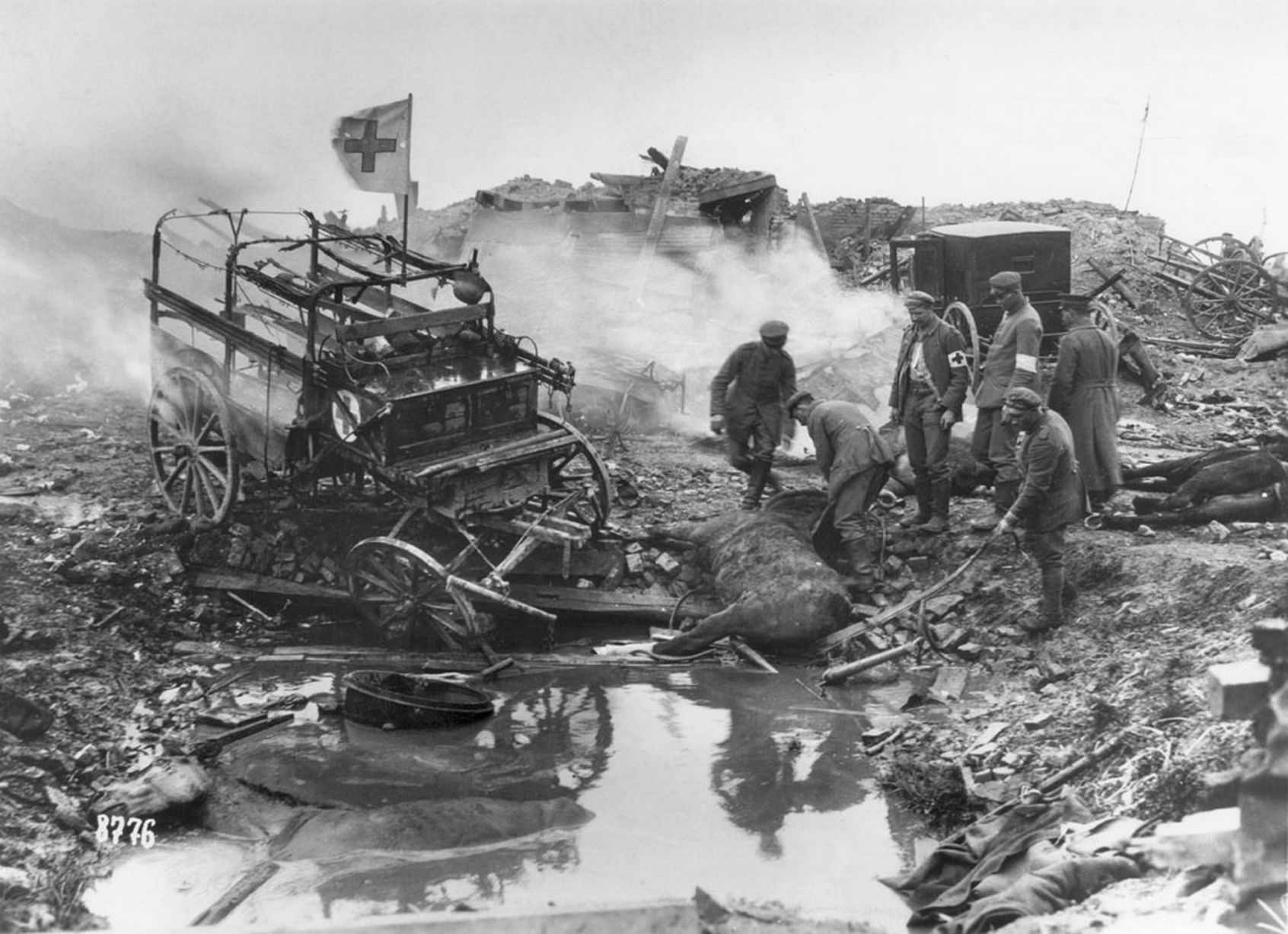
The Entente Powers decided against prolonging the war and trying to take over Germany. That no doubt would’ve been difficult and they wanted Germany there anyway as a bulwark against newly communist Russia, soon to become the Soviet Union. Germany agreed to an armistice at 11:00 a.m. on November 11th, 1918 after President Wilson promised them favorable terms in the peace negotiations. Throngs filled the streets of England, France, and the U.S. in jubilation, but some Germans didn’t realize their cease-fire was seen as a full-blown capitulation in the West. In other words, some Germans didn’t think they’d lost the war, though their generals relinquished their armaments and they agreed at the time to some reparations and territorial loss. Still, the Western Front hadn’t crossed over into Germany and Germany held some French territory. This misunderstanding over the armistice complicated post-war negotiations and inter-war history prior to WWII.
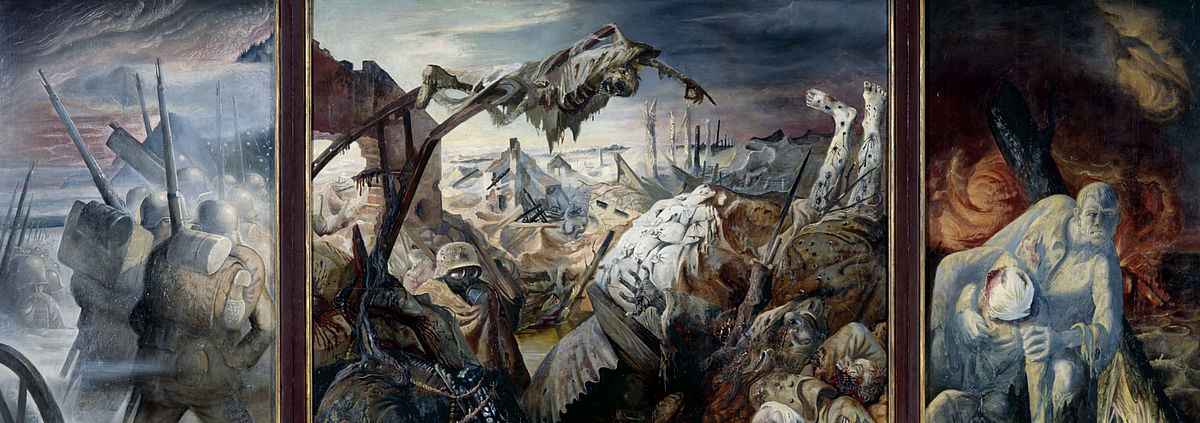
Otto Dix, The War (aka Dresden Triptych), 1929-32, Albertinum, Dresden. Artist’s self-portrait on the right.
This is a good time for a break, as this is a hefty chapter. Re-charge your battery and return when ready.
Easter Uprising & Bolshevik Revolution
The war transformed several countries and empires throughout Eastern Europe and the Middle East and led to independence in Ireland, Poland, and Finland. In Eastern Europe, the Austro-Hungarian Empire, whose attack on Serbia exploded the powder keg in 1914, collapsed at war’s end, leading to numerous individual countries including Austria, Hungary, Czechoslovakia, and Yugoslavia (until 1929, the “Kingdom of Serbs, Croats and Slovenes”). With the abdication of Kaiser Wilhelm II, the German Empire that consolidated in 1871 transitioned into a republic, headquartered in Weimar. In the Middle East, the Ottoman Empire also dissolved, leaving the core remnant of Turkey but allowing Western Allies to carve up the Middle East, as we’ll see below.
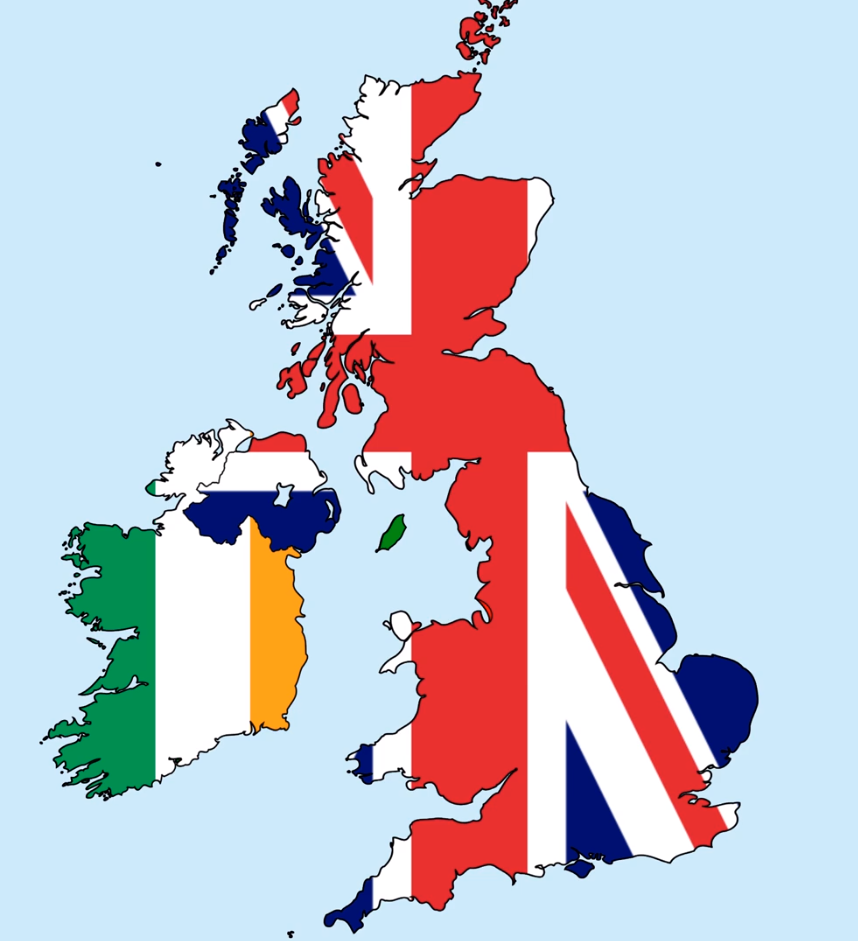 Irish troops fought alongside other British (English, Welsh, and Scottish) in the war, and many served with distinction. But the Irish Republican Brotherhood and Irish Volunteer Force were disgruntled with Irish losses on the Western Front and with their country’s lack of autonomy within the British Empire. They appealed to Germany for support and Germans even sent an arms shipment that the English intercepted. Britain’s preoccupation with fighting Germany left them shorthanded in the Easter Uprising of 1916, during which Arthur Zimmerman had more luck stirring up rebellion than in Mexico. After a five-year war, the Irish gained independence in 1922 everywhere except Ulster, or Northern Ireland. After 1949, the rest of Ireland was no longer a dominion state within the United Kingdom.
Irish troops fought alongside other British (English, Welsh, and Scottish) in the war, and many served with distinction. But the Irish Republican Brotherhood and Irish Volunteer Force were disgruntled with Irish losses on the Western Front and with their country’s lack of autonomy within the British Empire. They appealed to Germany for support and Germans even sent an arms shipment that the English intercepted. Britain’s preoccupation with fighting Germany left them shorthanded in the Easter Uprising of 1916, during which Arthur Zimmerman had more luck stirring up rebellion than in Mexico. After a five-year war, the Irish gained independence in 1922 everywhere except Ulster, or Northern Ireland. After 1949, the rest of Ireland was no longer a dominion state within the United Kingdom.
Zimmerman was also involved in Russia. There, a bread riot in February 1917 mushroomed into a revolution, leading to the overthrow of Czar Nicholas Romanov’s monarchy. In April, Germany facilitated the journey of Bolshevik revolutionary Vladimir Lenin, who’d been exiled in Switzerland since 1900, back to St. Petersburg, Russia to rebel against the moderate faction of the Socialist Revolutionary Party’s Provisional Government led by Alexander Kerensky, who wanted to continue the war against Germany. (Edmund Wilson’s epic history of European socialism was titled To the Finland Station after the Finlyandsky train depot.) This was a long-term risk for Germany because they knew that if Lenin succeeded, that could boomerang in the form of an increased threat of communism in Germany, which happened in the 1920s and early ’30s with the German Red Front (KPD) usually polling ~ 10-15%.
Lenin promised Russians Land, Bread, and Peace, meaning an end to the war with Germany on the Eastern Front, along with peasants inheriting the land via the government. Communist Bolsheviks killed Czar Nicholas II and his family in the unrest that followed the Bolshevik’s October Revolution, including Queen Victoria’s granddaughter, Alexandra. After Russia sued for peace with Germany, the country fell into a civil war between Reds (hard-core Bolshevik communists), the Social Revolutionary Party (SRs), and Whites (or Mensheviks), the latter two of which had various factions but favored democratic socialism. Lenin called elections in November 1917 but the SRs won big, so he declared a dictatorship to keep the Bolsheviks in power — outlawing voting, political parties, and freedom of the press and vowing to kill anyone who opposed them. Estimates vary widely as to how many the Bolsheviks murdered in the ensuing Red Terror, but they deliberately included a lot of innocent non-combatants to underscore their ruthlessness. The Reds had launched a people’s revolution but transformed into a brutal dictatorship after their victory, which led to the Russian Civil War (1917-23) between Reds and the White Guard. Russia also continued to fight for territory with Poland. Like Ireland, an independent Poland was another by-product of the Great War, though it had existed historically in various forms.
The U.S. diverted two infantry regiments to Russia, ostensibly to explore re-opening an Eastern Front but really hoping to influence Russia’s civil war and to help secure American and British weapons from falling into communist hands. As far back as 1917, the U.S. wanted to overthrow the Soviet Union, assassinate Lenin, and get Russia back into the war to alleviate pressure on the Western Front (optional article below). After the war, President Wilson preferred what he saw as the lesser of two evils, the more moderate democratic socialist factions that favored elections, but they lost to the Bolsheviks (Reds). The post-war Allied Intervention, comprised of Americans, British, French, and Japanese forces, failed and only further alienated the victorious Bolsheviks. Wilson admitted as much. For the most part, the intervention also failed to make its way into American history textbooks, but that wasn’t the case in Russia. Communists remembered Britain’s Ministry of Munitions, Winston Churchill, saying, “We must strangle the infant Bolshevism in its cradle.”
Finland broke away from Russia during the Revolution. However, in 1922, Russia added two Baltic countries (Lithuania and Latvia), Georgia, Ukraine, Kazakhstan, and other Asian territories, consolidating into the larger Soviet Union, or USSR, that the U.S. refused to recognize diplomatically until 1933. The tension between the two countries started at the end of WWI rather than just after WWII with the Cold War, as is commonly thought, though they were allies during World War II.
Once the foreigners left and the Mensheviks were defeated, the Bolsheviks murdered the soldiers and sailors that had helped them gain power in 1917 under the impression that they were fighting for democratic socialism. Like European powers who argued that Asians and Africans weren’t ready for democracy, Lenin argued that Russian peasants weren’t ready either and needed “vanguard” leadership to seize and control the means of production (farms and factories). As the saying goes, revolutions often “devour their own children.”
Events in Russia were typical of the instability that racked much of Europe after the war. The destruction of old monarchies and empires opened the question as to what modern form of government would replace them. Many European countries, including Germany, Hungary, Italy, and Spain experienced civil wars in the decades that followed as fascists, communists, and republicans jostled for power.
Red Scare
World War I was a bonanza for Wall Street, with the market doubling and corporate profits tripling. The war created 42k new millionaires, mostly in the financial sector. But many Americans didn’t share in the bounty and conservatives feared a Bolshevik-style revolution at home. Now, after Russia’s revolution, Karl Marx wasn’t just a writer that dreamers read or rallied around. Communism had actually taken root in a major country, even if just on Europe’s rural, eastern frontier. Real American revolutionaries rose up and authorities also harassed and arrested innocent leftist labor leaders and radicals in what’s known as the First Red Scare, less famous than the one from 1948-1953. The government deported ~ 250 communists and anarchists to Russia, often blurring the line between radicals and more mainstream strikers by raiding and deporting so-called “bolshevik” labor leaders (steelworkers and some police went on strike after the war, and rail workers threatened to). The Great War, Russian Revolution, and Red Scare provided context for the brutal Mine Wars in West Virginia that we read about in Chapter 2. In the Seattle General Strike, 65k workers from a swath of unions walked off the job for a week and critics led by Seattle Mayor Ole Hanson blamed Russia. Connected general strikes (aka secondary boycotts, sympathy strikes, or solidarity actions) are when capitalists get nervous because they can throw a monkey wrench into the economy, just as Chicago’s 1894 Pullman-inspired Rail Strike did nationwide and a coal-steel-auto strikes did in 1945-46.
Some radicals were indeed dangerous, as we also saw in Chapter 2. Anarchists sent mail bombs to principal investigators, but most malfunctioned or went unopened because they were too well marked with recognizable clues. Anarchists threatened to kill Carnegie, Vanderbilt, and Rockefeller and sent a failed booby-trap bomb to liberal Attorney General A. Mitchell Palmer, whom Wilson brought on board to appease labor, and later blew up a bomb on Mitchell’s porch that nearly killed his family and scattered the perpetrator in the street when it went off early. Likewise, anarchists in Chicago tried to kill leaders at a 1916 luncheon but they put too much arsenic in their soup and the smell made the men sick before they ate it, saving their lives. Anarchists set off bombs in eight cities in 1919. In April 1919 alone, insurrectionists sent 36 dynamite bombs to leading American authorities, political and financial, leading Mitchell to form a [anti-] Radical Division in the Justice Department headed by J. Edgar Hoover. The Federal Bureau of Investigation (FBI) had already been tasked with investigating terrorism after the forenamed German attack on Black Tom Island in 1916. It grew into a major anti-crime agency within the DOJ during the First Red Scare and Prohibition, with Hoover in charge until his death in 1972. By then, he had so much dirt on America’s politicians that he was among the most powerful men in the country.
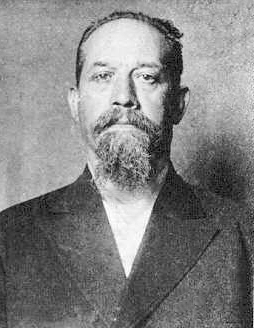 Some revolutionaries wanted to follow the Russian Bolsheviks’ lead and others were Italian anarchists led by Luigi Galleani (left) or Mario Buda, followers of the propaganda of the deed code of violence. Galleani’s books and newspapers enlightened readers on how to dynamite capitalists. Buda’s worst alleged attack was an explosion in front of the House of Morgan (J.P. Morgan) at 23 Wall Street that killed 38 and injured 400 in 1920. The wagonful of dynamite mainly harmed young financial clerks rather than its presumed intended plutocrats. Despite a three-month investigation, the government failed to connect the Wall Street Bombing to communist Russia. But this senseless high-profile slaughter marginalized the American left, vindicating the rights’ labeling of the broader labor movement as violent extremism. Morgan’s bank left the damage on its facade as a sort of capitalist stigmata.
Some revolutionaries wanted to follow the Russian Bolsheviks’ lead and others were Italian anarchists led by Luigi Galleani (left) or Mario Buda, followers of the propaganda of the deed code of violence. Galleani’s books and newspapers enlightened readers on how to dynamite capitalists. Buda’s worst alleged attack was an explosion in front of the House of Morgan (J.P. Morgan) at 23 Wall Street that killed 38 and injured 400 in 1920. The wagonful of dynamite mainly harmed young financial clerks rather than its presumed intended plutocrats. Despite a three-month investigation, the government failed to connect the Wall Street Bombing to communist Russia. But this senseless high-profile slaughter marginalized the American left, vindicating the rights’ labeling of the broader labor movement as violent extremism. Morgan’s bank left the damage on its facade as a sort of capitalist stigmata.
Labor Day had been celebrated in the U.S. since the 1890s when President Grover Cleveland tried to appease workers with a holiday after the Haymarket Affair and Pullman Riots in Chicago (Chapter 2). People fought over the Labor Day date, though, since leftists and workers across the world celebrated on May Day to signal their solidarity. On May 1st, 1919, four months before the Wall Street bombing, labor parades in Cleveland, Boston, and New York led to violent clashes between police and marchers, especially those carrying socialist red flags. In the Brainiest Man Case, in an obvious subversion of the First Amendment right to free speech, a grammatically-incorrect Connecticut man spent six months in jail for saying that Lenin was the “most brainiest man on earth.”
While that and dozens of other incidents were overreactions, the idea that communists intended a global, not just Russian, revolution was accurate. On the right is a Soviet propaganda poster showing Lenin sweeping away the Western evils of monarchy, superstition, and capitalism. Presumably, the “moneybags” character toward the bottom represents America. The Great War shifted the seat of global finance from London to New York City as the U.S. became the world’s leading creditor nation. The Communist Party was a worldwide organization and CPUSA launched in Chicago in 1919 after a split with the Democratic Socialists. They never attracted wide membership and didn’t bomb A. Mitchell Palmer or Wall Street — you could say that Italian anarchists inspired the Red Scare of 1919-1920 against American Bolsheviks and other radicals — but CPUSA worked in tandem with Moscow and did their best to manipulate and/or infiltrate more mainstream American liberals and progressives while J. Edgar Hoover monitored, cataloged, deported, harassed, arrested, and occasionally killed radicals on America’s far left and right. By the end of the Great War, the FBI had expanded its role beyond law enforcement as the government concluded that it needed to police America’s political margins.
Versailles Treaty
Meanwhile, at the Paris Peace Conference, held in the Versailles Palace outside Paris, the U.S., Britain, and France hammered out terms for a series of treaties, the most famous of which was the Treaty of Versailles that dealt with Germany. Italy and Japan also attended briefly then left, while they excluded Germany altogether until after the first draft. American President Woodrow Wilson pushed his progressive dream of making the war worthwhile through his Fourteen Points. These included countries’ right to self-determination (to rules themselves), neutrality at sea, and creation of an international police organization to mediate disputes: the League of Nations. He wasn’t the first to imagine such an organization; Alexander I of Russia envisaged something similar a century earlier at the 1815 Congress of Vienna. Wilson had struggled to articulate his war aims to Americans — the bankers’ need to get their loans repaid wouldn’t have cut it — so he spun the conflict as a war to make the “world safe for democracy.” But Wilson was right that, at least in the struggle between Germany and France/Britain on the Western Front, this was a war between authoritarianism and liberalism (broadly defined).
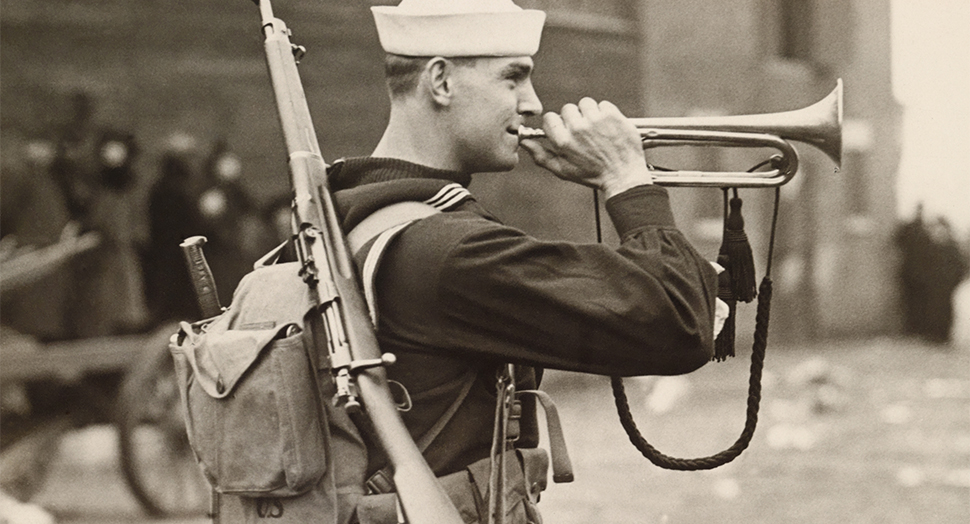 The Fourteen Points included some bold claims considering that most of the world at the time wasn’t democratic and America, up until then, hadn’t aggressively exported its political ideals. The flip side to the Monroe Doctrine (1823), that warned Europe to stay out of Latin America, was that the U.S. would never intervene in Europe. In addition, the right to self-determination (self-rule, Article 5), if indeed that was what the ambiguously-worded Article 5 established, was a radical idea since Europeans had colonized much of the world, including all of Africa and much of the Middle East and Asia. Wilson really only advocated self-rule for European ethnic groups, but that created (or reconstituted) new countries in Europe like Poland and Czechoslovakia that many people had no initial patriotic attachment to. Article 10 established self-rule for inhabitants of the former Austro-Hungarian Empire, but they denied self-determination for German-speaking people in Austria, the Sudetenland (Czechoslovakia), Upper Silesia (between Germany and Poland), and Memelland (Prussian Lithuania, now Klaipeda). Later, Adolf Hitler played on resentment in those areas as he expanded through Europe, meeting little resistance in areas that already spoke German. As for Wilson’s restrictions on colonization, Europeans hadn’t fought the Great War to give up territories; they’d fought it to gain more. Of course, that’s why Wilson wisely wanted to get rid of colonization in the first place, so that it wouldn’t lead to future wars the way it had contributed to this one.
The Fourteen Points included some bold claims considering that most of the world at the time wasn’t democratic and America, up until then, hadn’t aggressively exported its political ideals. The flip side to the Monroe Doctrine (1823), that warned Europe to stay out of Latin America, was that the U.S. would never intervene in Europe. In addition, the right to self-determination (self-rule, Article 5), if indeed that was what the ambiguously-worded Article 5 established, was a radical idea since Europeans had colonized much of the world, including all of Africa and much of the Middle East and Asia. Wilson really only advocated self-rule for European ethnic groups, but that created (or reconstituted) new countries in Europe like Poland and Czechoslovakia that many people had no initial patriotic attachment to. Article 10 established self-rule for inhabitants of the former Austro-Hungarian Empire, but they denied self-determination for German-speaking people in Austria, the Sudetenland (Czechoslovakia), Upper Silesia (between Germany and Poland), and Memelland (Prussian Lithuania, now Klaipeda). Later, Adolf Hitler played on resentment in those areas as he expanded through Europe, meeting little resistance in areas that already spoke German. As for Wilson’s restrictions on colonization, Europeans hadn’t fought the Great War to give up territories; they’d fought it to gain more. Of course, that’s why Wilson wisely wanted to get rid of colonization in the first place, so that it wouldn’t lead to future wars the way it had contributed to this one.
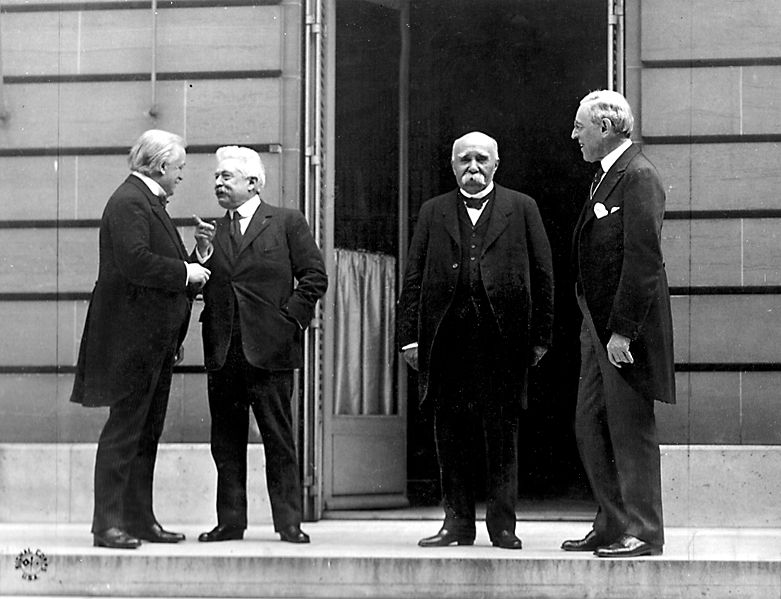
Council of Four at the WWI Paris Peace Conference, May 1919, (L – R) Prime Minister David Lloyd George (Great Britain), Premier Vittorio Orlando (Italy), Premier Georges Clemenceau (France), President Woodrow Wilson (U.S.), Photo by Edward Jackson, U.S. Army Signal Corps
For the French and British, Wilson was overly idealistic, stemming from his background as a staunch Presbyterian, history professor, and college administrator. This was the real world. French President Georges Clemenceau said that Wilson “brought a Bible to a poker game.” As for Wilson’s Fourteen Points, Clemenceau joked, “God only gave us Ten Commandments, and we quickly enough learned to break those.” Wilson then caught the flu during the conference, hampering his efforts to impose his will on the settlement and perhaps contributing to his death from a stroke two years later.
Self-determination was at least popular among young Third World attendees like Mao Zedong of China and Ho Chi Minh of French Indochina, but European and Japanese victors were anxious to divide their loot, not forfeit it (especially Germany’s colonies). They divided up the globe with what they called mandates, rationalized by vague promises of future self-determination when those with more skin pigment were ready. Ho, who attended the Versailles Conference as a student, later led the North Vietnamese opposition against the French in the 1950s and as a figure-head against the U.S. in the 1960s. Mao led the communist takeover of China in 1949. Leaders from Egypt, India, and Korea also embraced Wilson’s ideal of self-rule, though not always in the way he intended.
But that was many years down the road. In 1919, Western Allies huddled over a map and carved up the world with a compass and ruler, often with no regard for regional ethnic make-up. Wilson argued, in his expansion on Point #12, that a separate country should be created for Kurds, but the rest ignored him and created the new country of Iraq, mixing Kurds and Shia and Sunni Muslims. The Ottoman Empire, a German ally, had controlled most of the Middle East, but only the new nation of Turkey remained as its rump state. Elsewhere, Arab uprisings and jihads against Ottomans spurred by the British, including High Commissioner in Egypt Sir Henry McMahon and T.E. Lawrence (Lawrence of Arabia), only resulted in Britain and France divvying up the oil-rich region for themselves in the secret Sykes-Picot Agreement of 1916. The companies now known as BP and TotalEnergies would extract the oil. First, Lawrence helped nomadic Arab Bedouins wreak havoc on the Ottoman Turks’ railroad, telephone, and telegraph lines in the Arab Revolt of World War I. But the British only inspired Arabs to overthrow Ottomans so that they could take the Middle East for themselves, over-ruling leaders like Hussein bin Ali, Sharif of Mecca, who’d led the Arab Revolt alongside Lawrence. They tried to peel off the loyalty of indigenous elite by granting quasi-autonomy to leaders like King Faisal I of Syria and Iraq to run domestic affairs (the boring stuff they weren’t interested in), similar to how the U.S. operated Cuba as a protectorate after the Spanish-American War and how American sugar planters partnered with Hawaiian leaders (Chapter 3). Archaeologist and explorer Gertrude Bell, the first influential woman in British intelligence, tutored Lawrence in Arab geography, drew the lines creating Iraq, and handpicked Faisal as first king.
Resentment over the British and French ploy helped kick-start Pan-Arab sentiment: the idea that Arab people in the Middle East and North Africa should unite to fend off Western imperialism. The extreme end of the Pan-Arab spectrum included terrorists. As ISIS expanded into Iraq and Syria in the 2010s, leader Abu Bakr al-Baghdadi vowed to erase the old colonial borders, saying “This blessed advance will not stop until we hit the last nail in the coffin of the Sykes-Picot conspiracy.” Additionally, the Great War galvanized the Zionist idea of creating a new Jewish country out of ancient Israel. European Zionism grew in the 19th century, gained momentum after WWI, and culminated in nationhood in 1947-48, after the Holocaust. No one expressed much concern for the Arab/Muslim Palestinians who already lived in the Levant and McMahon never told Arab leaders that the British were already planning to carve out a Jewish homeland there even as they were encouraging them to overthrow the Turks (first 1917 Balfour Letter). The Syrian Civil War (2011- ) and both American wars in Iraq (1990-91, 2003-11) traced indirectly to Europeans’ clumsy re-mapping of the Ottoman Empire during and after World War I.
Wilson’s pre-armistice promise to Germany of good peace terms went unheeded in Paris. But Germany agreed to a cease-fire under those generous terms and some Germans didn’t even think they had surrendered, only that they’d agreed to a truce. They never formally acknowledged defeat or culpability for starting the war. However, they’d surrendered their weapons on the Western Front and now France and Britain wanted them crushed so that they’d never rise again. Wilson, and to a lesser extent British Prime Minister David Lloyd George, worried that such retribution would only make Germany vengeful. He even predicted a “future German demi-God.” However, the French and other allies drowned out their concerns and Wilson’s stance also hardened as the conference progressed. As mentioned, the Allies wanted an independent Germany to serve as a bulwark against Soviet communism, but the final treaty aimed to keep it weak rather than integrating Germany into a new order. The initial German delegation refused to sign such a one-sided treaty, but the Allies didn’t blink. Eventually, Germany sent a second group of envoys that reluctantly and bitterly signed the Versailles Peace Treaty. It’s worth noting that in their Septemberprogramm of 1914, Germany had drawn up their own expansionist and harsh peace terms when they assumed they would win the war.
Germany conceded the Rhineland to France, the area Prussia seized in 1871, and agreed to not maintain a large, standing military. They also gave up over 90% of their merchant fleet. The Rhineland concession, along with losing Poland, cost Germany over 13% of its land and 10% of its population. They surrendered their African colonies and Pacific islands (to Japan). The North Sea blockade around Germany continued for 18 months after the war and they were forced to pay reparations (debts) to the victorious nations, that they finally paid off in 2010. Germany could not get out from under the debt and the generation that came of age under the Versailles Treaty and blockade, that included food and medicine, became the Nazis led by Lloyd George’s feared demigod, Adolph Hitler. In the Versailles Treaty’s Article 231, later known as the War Guilt Clause, the Allies blamed Germany for the entire war. Though Wilson had promised good terms and worried about an overly punitive peace, it was American diplomats, future Secretary of State John Foster Dulles and Undersecretary of State Norman Davis, who co-authored the clause.
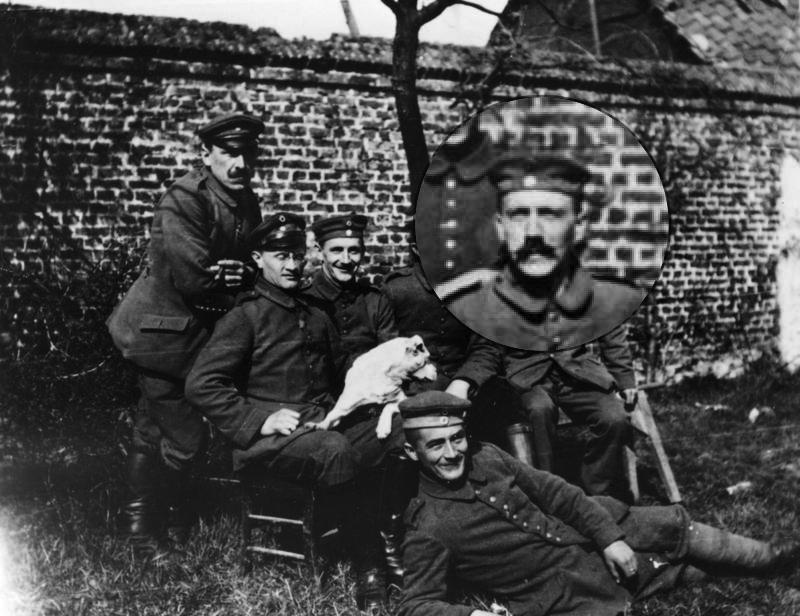
Hitler (far right, seated) with his army comrades of the Bavarian Reserve Infantry Regiment 16 (c. 1914–18)
Hitler, a corporal in WWI (above), didn’t vent against Germany’s loss so much as the peace treaty’s harsh terms and the “treasonous” Germans who’d agreed to it. Thus, after killing anywhere from 10-20 million people counting civilians, the “war to end all wars” failed to resolve the fundamental issue that had caused it: the unsettled rivalries between European countries. Its botched peace treaty only increased the odds of future conflict. The demoralizing conflict also fostered atheism and nihilistic art across Europe, fueling the Dada Movement and Surrealism.
American presidents or diplomats do not ratify foreign treaties by themselves. They must come home and get Congress to ratify by a two-thirds majority whatever they’ve conditionally agreed to. Republicans were upset that Wilson hadn’t included many of them on his French trip (Dulles was an exception). But the bigger concern was the Versailles Treaty’s inclusion of Wilson’s League of Nations. Republicans and some Democrats understandably didn’t want to over-extend the U.S. by agreeing to intervene all over the planet to preserve peace. Republican leaders like Henry Cabot Lodge were willing to commit to protecting the eastern French border from Germany, but not to the League of Nations. The U.S. occupied the newly acquired Rhineland region for France until 1923. Both Wilson and the GOP were willing to protect American interests, but only Wilson wanted to police ulterior conflicts. The Covenant of the League of Nations’ Article X seemed to suggest that the U.S. military was subordinate to the League since the League could call members to fight without U.S. congressional authorization.
Thus, the League of Nations came into being but without America, whose president conceived it. Wilson campaigned tirelessly on its behalf in a whistle-stop campaign, zigzagging across the country in a train, but worked himself nearly to death and lost the treaty fight. He suffered a debilitating stroke a year before his second term ended, then passed away in 1924. The U.S. never signed the Versailles Treaty, though they signed a separate pact with Germany later. The League came into being but lacked authority to use force in the 1920s and ’30s. Meanwhile, Germany’s unmanageable debt contributed to a worldwide economic meltdown, and Germany and Japan took advantage of everyone else’s desire to avoid another conflict as calamitous as the Great War (Chapter 10).
Coda: The Influenza Pandemic
So ended one of the worst fiascos in recorded history. If poet W.B. Yeats was wrong to suppose that it would trigger the Second Coming of Christ, ambulance driver Ernest Hemingway could plausibly call the Great War the “most colossal, murderous, mismanaged butchery that has ever taken place on earth.” If he was right, it was only for a while as WWII and the Holocaust upstaged it for that honor within a generation, followed by the brutal communist totalitarianism of Joseph Stalin and Mao Zedong. 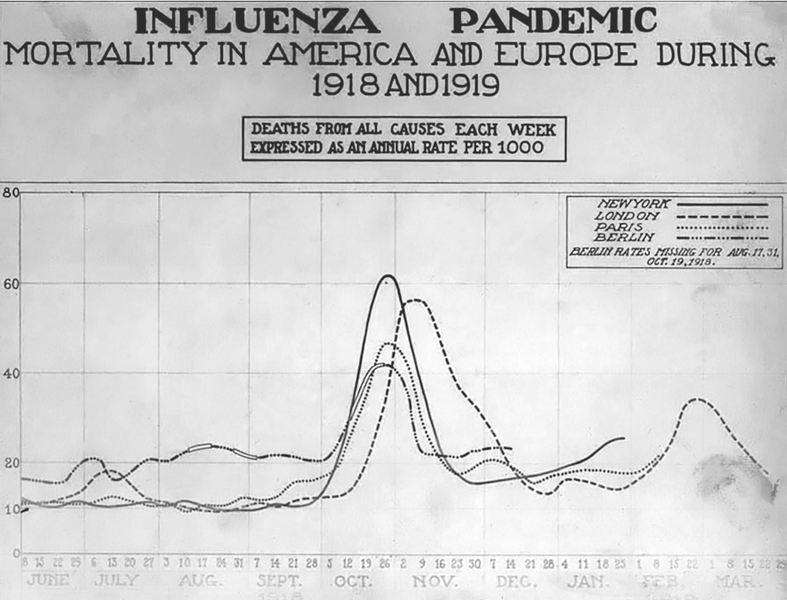
Then, just in case the war hadn’t wreaked enough havoc and despair, the worst flu pandemic in modern history spread around the globe in 1918-19, killing another 50-100 million people. Historians suspect but haven’t proven that flu trauma contributed to contemporaneous phenomena like Red Summer, the First Red Scare, skepticism toward the League of Nations, and the anti-immigration backlash that we’ll explore in the next chapter.
Estimates vary widely as to the final death count but, at a minimum, probably ~ 5x more people died from influenza than died in combat during the war. India, alone, lost over 17 million. It was an H1N1 so-called “swine flu” but originated in birds not pigs (CDC). It attacked people across the age spectrum, often killing victims within 24-48 hours. It’s possible that the elderly suffered less because they’d been exposed to similar flu strains earlier in life. Army data indicated that the outbreak started at Camp Funston, Kansas, now Fort Riley, likely in the mess hall or kitchen. If true, American intervention in the Great War had a tremendous, if unintentional, downside, though the U.S. tipped the scale militarily in favor of the allied victory. However, modern science historians are skeptical of single origin theories among humans, instead pointing to strains from various regions mutating as they overlapped during the war. We’ll never know the answer to the counterfactual “what if” question of how the war would’ve turned out minus American intervention or the flu’s impact. Troop mobilization explained why the contagion spread so widely and some speculate that it might have shortened the war.
The strain mistakenly called “Spanish Flu” didn’t originate there. The Spanish just wrote about it in their papers because, as a neutral country, they were one of the few places that didn’t outlaw reporting about it, while others thought it would weaken their war effort. In America, it came in three waves, with a milder version in Spring 1918 as soldiers shipped out, the biggest outbreak when they returned, and a milder third wave in 1919. After mutating into a stronger strain overseas, the second wave re-entered the U.S. at naval stations in Boston and Philadelphia at war’s end, then hit Pittsburgh the hardest because veteran steelworkers there already had early lung disease from the mills and the city’s air was polluted. The final death toll in the U.S. was ~ 675k, the equivalent of over two million in the 2020 population.
In the U.S., entire towns quarantined themselves (or tried) and people wore masks for months. Germ theory (aka the bacterial revolution) originated in the late 19th century and they knew how germs spread, but their microscopes weren’t powerful enough to see viruses, which are much smaller than bacteria. Scientists suspected that smaller germs existed but viruses weren’t fully theorized until 1926 and photographed in 1940 under an electron microscope. Tuberculosis was a more prominent threat in the early 20th century and, with the flu, health officials luckily encouraged the same preventative measures of not coughing and sneezing on each other, spitting tobacco juice, sharing cups, etc., often retrofitting the same information posters and newspaper cartoons. Some anti-maskers forged fake messages from the Surgeon General warning of a pro-mask conspiracy. And an anti-mask league in San Francisco complained about the violation of their personal liberties but, for the most part, local authorities cleverly spun mask-wearing as patriotic by describing the uncooperative as “mask slackers,” tying them to draft-dodging “slackers.” Political cartoons of the era evoked similar concerns as they did a century later. Kleenex® started marketing their facial tissues as disposable handkerchiefs, whereas their original purpose was just for women to remove mascara. The term influenza is Italian for influence, as in the illness perhaps being influenced by the misalignment of the planets.
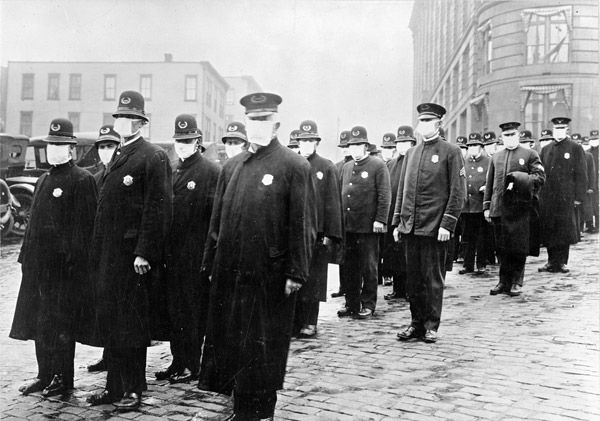
Policemen in Seattle Wearing Masks Made by the Red Cross, During the Influenza Pandemic, December 1918
There was at least one silver lining coming out of this depressing cloud. In an effort to prevent wounded soldiers dying from bacterial infections, Sir Alexander Fleming initiated research that culminated a decade later in the discovery of the world’s first antibiotic, penicillin. Antibiotics have undoubtedly saved more lives since then than were lost in the Great War, but we’ve made less progress on antivirals, relying instead on vaccines.
The 1918 flu might teach us an important lesson. During the recent COVID-19 outbreak we debated sheltering-in-place versus economic vitality, but that was a false dilemma. While shutting down no doubt harms the economy in the short run, recent research from M.I.T. and the Federal Reserve shows that cities that intervened earlier and sustained their lockdowns longer in 1918 did better economically in 1919 as measured by employment and manufacturing output (MIT Sloan). But we need to caution against drawing simplistic historical analogies. The two pandemics are separated by over a century, the economic and social contexts were different, we now have vaccines and, most importantly, coronavirus isn’t the flu. As Mark Twain likely didn’t say but we wish he did: “History doesn’t repeat itself, but it often rhymes.”
Optional Viewing, Listening & Reading:
Jeff Gusky, The Hidden World of World War I (Trench-Cave Carvings)
Backstory, “Great War: the Long Shadow of WWI,” Virginia Foundation for the Humanities (55:12)
World War One & Wilsonian Foreign Policy, Department of State: Office of Historian
Cabanes, Siegal & Retish, “The Long Legacy of World War I” (Origins, 2018)
Zachary Keck, “The Great Myth: World War I Was No Accident,” The Diplomat
World War I: Every Day (Animated Map, YouTube)
Michael Lawson, “Omaha, A City In Ferment: Summer 1919” (Nebraska History 58, 1977)
Abigail Higgins, “Red Summer of 1919: How Black WWI Vets Fought Back Against Racist Mobs” (History 7.26.19)
Ben Yagoda, “What Drove Sigmund Freud To Co-Author A Scandalous Biography of Woodrow Wilson?” (Smithsonian, 9.18)
Kenneth Davis, “Philadelphia Threw a WWI Parade That Gave Thousands of Onlookers the Flu,” Smithsonian, 9.18)
Joe Richman & Nellie Gilles, “For Centenarian Survivor of 1918 Flu Pandemic, Coronavirus is Just Another Problem” (NPR, 4.20)
Video (1:41;23): Christopher McKnight Nichols, 1918 Flu Pandemic (C-SPAN, 8.27.20)
Thomas Ewing, “The Last Pandemic: Using History to Guide Us in the Difficult Present” (NEH, Summer 2020, 41:3)
Barnes Carr, “The Lenin Plot: The Concealed History of the U.S. Effort to Overthrow the USSR” (HNN, 10.11.20)
David Frum, “Uncancel Woodrow Wilson” (Atlantic, 3.24)
